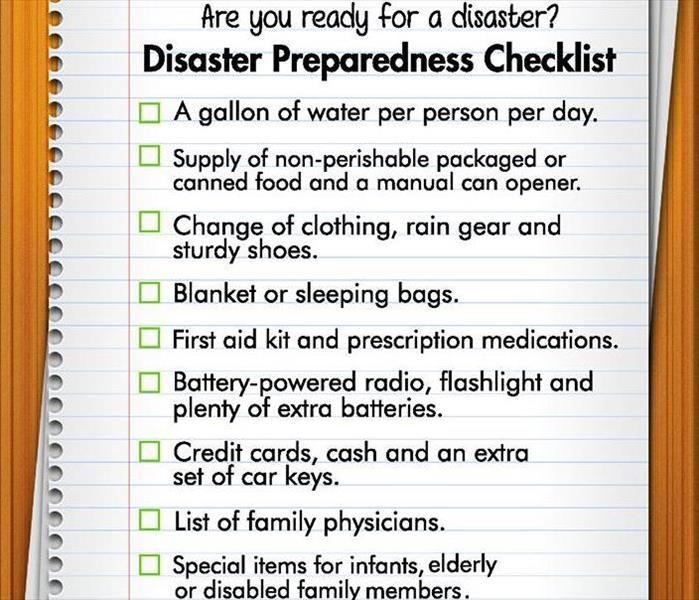Recent Storm Damage Posts
Prepare Now for the Peak of Atlantic Hurricane Season
9/17/2024 (Permalink)
The peak of the Atlantic hurricane season is September 10th, with most activity occurring between mid-August and mid-October, according to the National Oceanic and Atmospheric Administration.
According to the NOAA, the exact day of September 10th is the day you are mostly likely to find a tropical cyclone somewhere in the Atlantic, statistically speaking. This year, the peak of Hurricane Season coincided with Hurricane Francine in the Gulf of Mexico.
Do not wait to prepare yourself for a hurricane when a storm forms in the Atlantic and stores are filling with shoppers looking for emergency supplies.
There are steps that you can take now to ensure you and your household are more prepared for the peak hurricane season:
- Build a survival kit. You and your household should be prepared to shelter in a secure and safe location for several days after a disaster when roads may be impassable, gas stations and grocery stores closed, power and communications being out. Common items are water—drinking and sanitation, food, medication, first aid kit and hygiene products.
- Make a Family Communication Plan. Choose an out-of-town friend or relative as a point of contact. Make sure children have emergency contacts memorized or saved in a secure place. Determine a safe, familiar place the family can go to reunite.
- Stay Informed. Listen to local officials for the most up-to-date information before, during and after a disaster. Keeping a battery or solar-powered radio to receive disaster notices and updates in your survival kit is key.
2024 Hurricane Season
5/24/2024 (Permalink)
NOAA National Weather Service forecasters are predicting an above-normal hurricane activity this year. The 2024 Hurricane Season spans from June 1st to November 30th. NOAA is forecasting a range of 17-25 total named storms (winds of 39 mph or higher). Out of those, 8-13 are forecast to become hurricanes with winds of 74 mph or higher and that includes 4 to 7 major hurricanes (cat 3, 4, 5).
FEMA in accordance with NOAA is recommending going ahead and preparing because severe weather and emergencies can happen at any moment. Taking a proactive approach today can make a difference in how quickly people can recover tomorrow.
NOAA is taking multiple steps to ensure better communications for the 2024 season.
- NOAA is implementing improvements to its forecast communications, decision support and storm recovery efforts this season.
- They are using new tools for hurricane analysis and forecasting.
- Upgrades to NOAA observing systems that are critical in understanding and forecasting hurricanes.
For more information on the 2024 hurricane season, visit www.noaa.gov.
Prepare for the Peak of Hurricane Season
8/28/2023 (Permalink)
The peak of the Atlantic hurricane season is September 10th, with most activity occurring between mid-August and mid-October, according to the National Oceanic and Atmospheric Administration. Do not wait to prepare yourself for a hurricane when a storm forms in the Atlantic and stores are filling with shoppers looking for emergency supplies.
There are steps that you can take now to ensure you and your household are more prepared for the peak hurricane season:
- Build a survival kit. You and your household should be prepared to shelter in a secure and safe location for several days after a disaster when roads may be impassable, gas stations and grocery stores closed, power and communications being out. Common items are water—drinking and sanitation, food, medication, first aid kit and hygiene products.
- Make a Family Communication Plan. Choose an out-of-town friend or relative as a point of contact. Make sure children have emergency contacts memorized or saved in a secure place. Determine a safe, familiar place the family can go to reunite.
- Stay Informed. Listen to local officials for the most up-to-date information before, during and after a disaster. Keeping a battery or solar-powered radio to receive disaster notices and updates in your survival kit is key.
NOAA on 2023 Hurricane Season
5/22/2023 (Permalink)
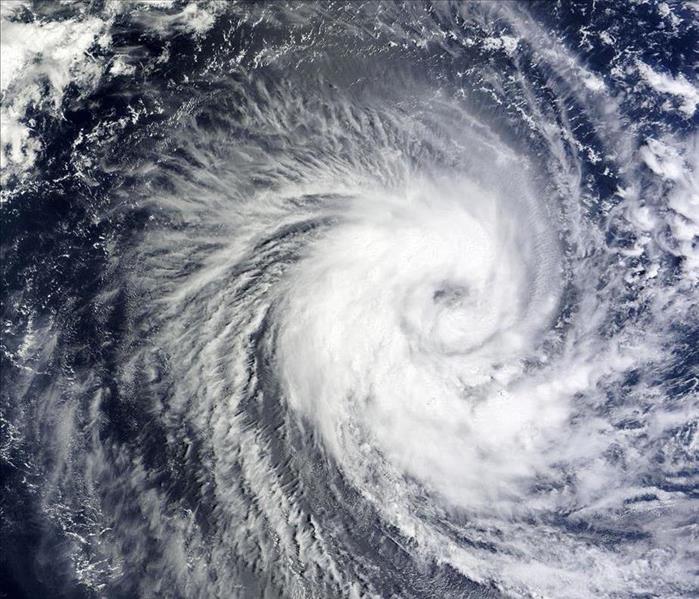 2023 Hurricane season starts June 1st.
2023 Hurricane season starts June 1st.
The National Oceanic and Atmospheric Administration is scheduled to issue its outlook for the 2023 Atlantic Hurricane season. The NOAA will discuss the expected number of storms and climate factors that will influence hurricane development. They will also provide advice on how to prepare for the upcoming hurricane season which officially begins on June 1st. The NOAA will also discuss their readiness for the season showcasing new products and upgrades to enhance forecasting and operations.
Hurricane names for the 2023 season have been released. There are new names in the rotation that will replace Harvey, Irma, Maria, and Nate. Those names will be replaced with Harold, Idalia, Margot, and Nigel.
Don’t forget to tune in on Thursday, May 25 to hear all about the 2023 Atlantic Hurricane Season!
4 Steps for Getting FEMA Assistance
8/27/2022 (Permalink)
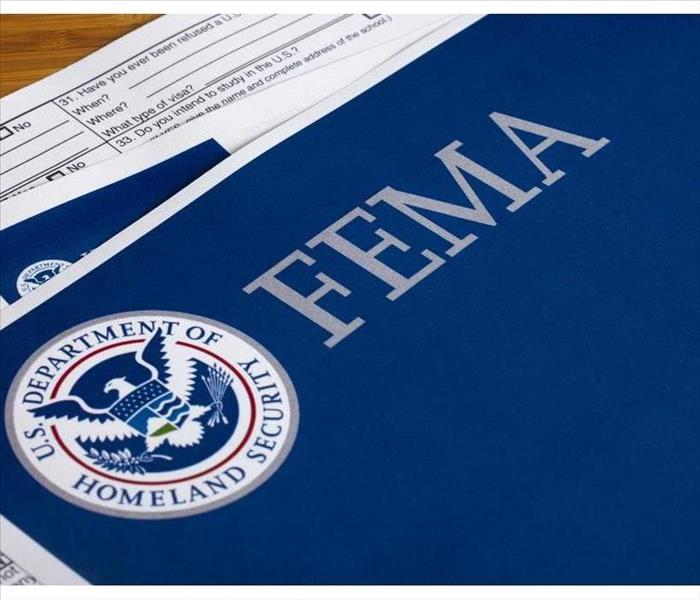 Get FEMA assistance
Get FEMA assistance
If your property isn't located in a floodplain or other area where flooding is a high risk, you may not have considered flood insurance to be a priority. Unfortunately, many types of natural and manmade disasters can result in flooding and water damage. For example, water leftover from firefighting efforts is a big concern after a fire. A burst pipe that goes unnoticed over a weekend can lead to significant flooding. Each of these situations may present unique requirements from your insurance company, but few situations are quite as complex as applying for FEMA coverage when you don't have insurance coverage.
Do You Qualify for Assistance?
According to the Federal Emergency Management Agency, people who own or manage property in eligible counties qualify for federal assistance. In the event that Clear Lake, TX, is an eligible community, property owners and managers should take the following steps:
Apply for Federal Aid
The first step in applying for aid from FEMA is either using the phone the call 800-621-3362 or visiting www.DisasterASsistance.gov. Whether you call or visit the website, you are likely to get in touch with a representative between 7 a.m. and 10 p.m., and it's possible to connect with someone all seven days of the week.
Identify Appropriate Grants
There are a variety of grants available whether you have flood insurance or not. If you own property with renters, you may connect some of your tenants with temporary housing. There are grants available for uninsured and underinsured property losses and emergency property repairs. Register for the grants that are most appropriate for your situation.
Attend Federal Inspections
A few days after you've registered by phone or online, a federal representative will contact you. They'll present official identification, won't ask for money, won't make recommendations, and won't approve or deny requests. However, they will make a careful survey of the damages your property has suffered. You'll receive official news about your claim after the inspection results have been submitted and reviews.
Check the Status of Your Case
You can follow the progress of your case by going online or calling the same federal help number. It's important that you understand the type of help you're going to receive before you contact commercial property damage agencies. You'll need specific flood insurance and FEMA information to share with these professionals.
The Need for Mitigation After Storm Damage
6/7/2022 (Permalink)
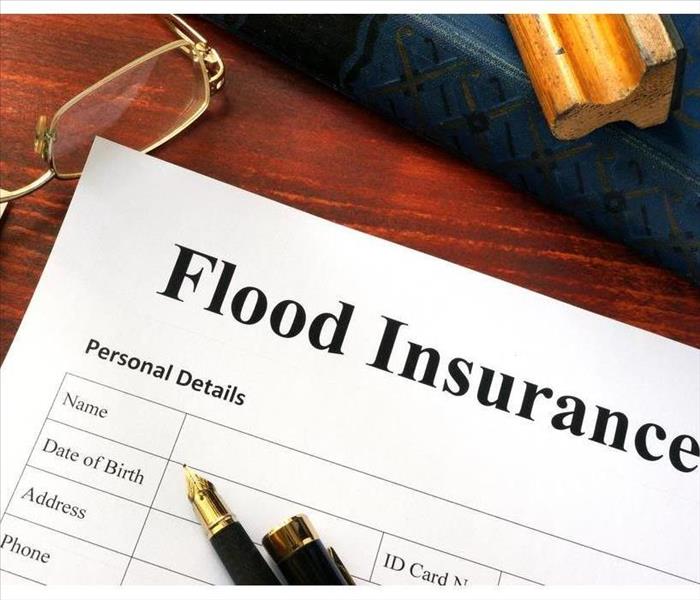 Having flood insurance is helpful.
Having flood insurance is helpful.
The Importance of Mitigation Following Storm Damage
Storm damage can run the gamut from flooding, roofing, and other damages. While having a storm and flood insurance is helpful, you cannot wait for an adjuster if you want to protect your home and claim. According to storm remediation services in Dickinson, TX, there are several reasons to act quickly to mitigate damage.
1. Flood Insurance Requirements
Many insurance companies require homeowners to protect their houses against further losses after damage. If a homeowner fails to mitigate problems resulting in other issues, such as water and mold damage, those losses may not be covered. Additionally, the failure to mitigate losses can jeopardize your entire claim.
2. Vandalism and Looting
Mitigation is about more than preventing further flood damage. Storm damage can result in broken windows, holes in roofs, etc. A damaged home is tempting for looters and vandals. These criminals might see a damaged home as an opportunity. Mitigation strategies aim to protect the home by sealing all entry points.
3. Animal Curiosity
Aside from human beings taking advantage of a vulnerable home, many animals will seize the opportunity to establish a nest or den. Even a damaged home can present an ideal home for some animals. Raccoons, squirrels, birds, etc., will likely find a manufactured structure preferable and safer than other options. Thankfully, standard mitigation practices will seal all entry points. You can also install temporary fencing to limit animal intrusion and curiosity further.
4. More Storms
Finally, waiting for an insurance adjuster before performing fundamental mitigation can leave your property vulnerable to future storms. Your insurance will likely not cover any damages occurring because of subsequent storms.
Most storm and flood insurance policies require homeowners to mitigate the possibility of further loss. Failing to protect your home can result in the rejection of a claim. Therefore, it is best to act fast after a storm, not waiting for adjusters and mitigating any sustained damage.
A Variety of Techniques Used to Limit Flood Damage
4/18/2022 (Permalink)
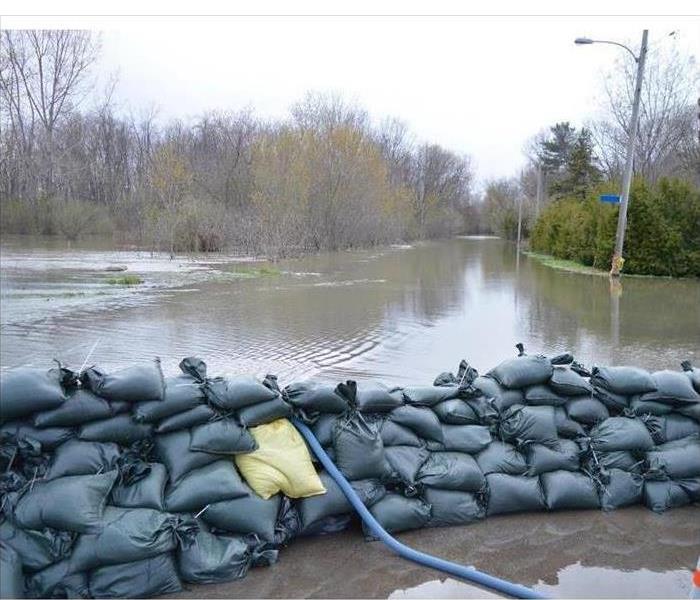 Sandbags are heavy and labor-intensive.
Sandbags are heavy and labor-intensive.
If you have ever worked to stop a flood, you might have some strong feelings about the ubiquitous sandbag. After all, this method of stopping high waters has been in use for well over a century, and it has many benefits. It is cheap and inexpensive and it forms a strong barrier to incoming water. On the negative side, though, sandbags are heavy and labor-intensive; if you have spent hours stacking them you completely understand this fact. For best results, the bags should be filled about half full and left untied at the top, though folded over. This makes them easier to lift and stack tightly.
Alternatives to the Sand Bag
If sand is not widely available, the bags can be filled with silt, which works nearly as well. Clay is an even more effective substance for flood dams, but it is notoriously difficult to put into bags, a nearly fatal flaw. Several other alternatives are in use during floods:
- The Hesco Bastion barrier requires heavy equipment and trained installers
- The Portadam which has been tested by the Army Corps of Engineers
- The Rapid Deployment Flood Wall showed lower seepage rates than sandbags
A company can also install more permanent barriers. These options include levees and earth berms which seek to divert water away from a building.
Options for Containing Flood Damage
If the water is just too high, your company in La Marque, TX, is likely to take on water. At this point, it is advisable to call in the services of a trained water mitigation team. The company will have a proven process to deal with water damage quickly and efficiently, working to limit the impact on your company and its bottom line. They will quickly remove any standing water, dry out saturated areas and clean surfaces tainted with dirty floodwaters. Both the low-tech sandbag and the advanced skills of a restoration team could play a role in protecting your company.
5 Things to Know for Winter Storm Preparedness
3/30/2022 (Permalink)
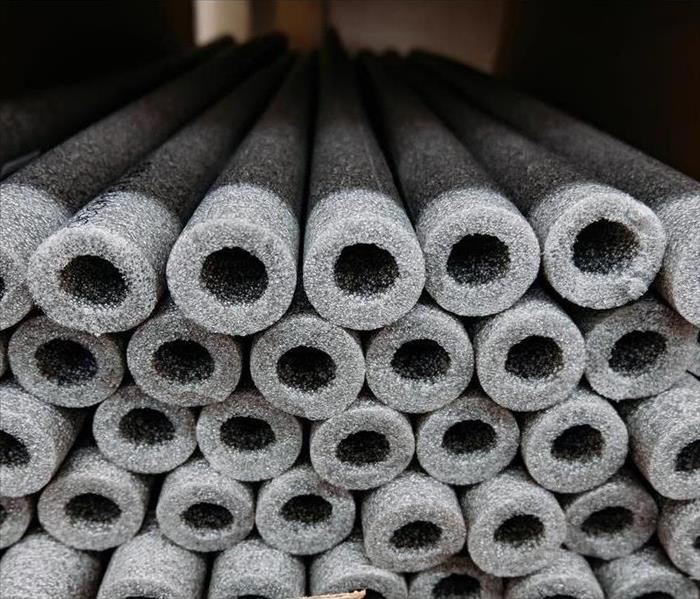 It's also important to make sure all the pipes in your home are insulated.
It's also important to make sure all the pipes in your home are insulated.
Winter Storm Warnings
If you live in an area such as Nassau Bay, TX, where you face regular winter storm warnings and potential damage, then you may be looking for some tips to winterize your home. Being prepared for winter weather cannot only help keep you warm, but can also help mitigate any storm damage your property may face. There are a few things you may want to consider.
1. Keep Supplies Handy
If you know that a storm may be coming, you may want to keep supplies on hand just in case. These may include supplies for protecting your home, extra food, pet supplies, shovels, batteries and flashlights.
2. Insulate your Pipes
It's also important to make sure all the pipes in your home are insulated if they could be exposed to a winter storm. This will help prevent them from freezing and possibly breaking.
3. Check your Roof
After a storm, you may want to check for roof damage. Doing this as quickly as possible can allow you to find any damage and take the necessary repair steps before a problem gets worse.
4. The Condition of Your Yard
Before a blizzard hits you may want to check your yard for trees with branches that could fall into your home when overloaded with snow. Sloped ground could lead to drainage pooling against your house, and other debris may cause a problem if picked up by the wind. You can take care of these hazards before the storm turns them into a bigger problem.
5. Who to Call for Help
You may also want to keep the number for a storm damage restoration company on hand just in case damage does occur. These professionals have the tools and knowledge needed to repair your home.
When preparing for a winter storm it's a good idea to keep supplies handy, insulate any exposed pipes in your home, and check the condition of both your roof and yard before the storm hits. These things can help you mitigate any damage that may occur. You may also want to have the number for a damage restoration professional handy, just in case.
After the Flood: 3 Actions To Take While Waiting for the Insurance Adjuster
1/11/2022 (Permalink)
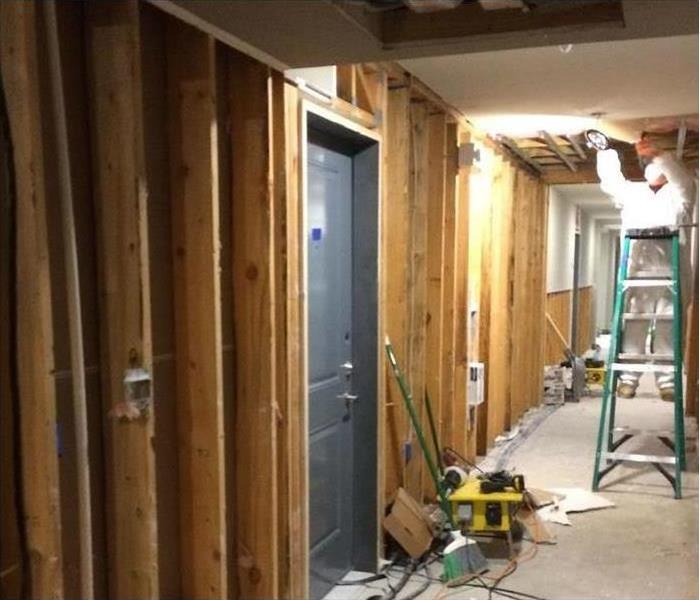 Nassau apartment damage.
Nassau apartment damage.
Protect Your Property and Prepare To File a Claim
When a large flood impacts Nassau Bay, TX, you will likely be one of many neighborhood residents filing a flood insurance claim. This is an effective way to protect yourself against any damage the flooding causes; however, waiting for the insurance adjuster can give flood waters time to cause further damage to your home. Fortunately, there are a few actions you can take in the meantime to protect your property and prepare to file a comprehensive claim.
1. Take Photos of the Damage
Once you know your home is safe to enter, begin by taking photos of flooded rooms and damaged items. Refrain from separating belongings during this stage and wear rubber boots and gloves for protection if you must enter flood waters. Catalogue whatever you find, including water stains on walls and ceilings, damaged furniture and ruined drywall.
2. Make a List of Valuables
Before you call in a flood damage and remediation service to drain flood waters from your home, make a list of any valuables that have been damaged. Include vehicles, artwork, jewelry and other items of value and list their estimated worth until you can access actual receipts. If any electronics, such as laptops, smartphones and tablets suffered water damage, retrieve their model and serial numbers to help expedite your claim once the adjuster arrives.
3. Call a Contractor
Have a contractor come in to check for water and mold damage so the adjuster can examine his or her findings and compare them with other damage estimates, such as the one the insurance company quotes you. Although each report may differ slightly when it comes to estimates, this can help you file a flood insurance claim with more efficiency.
Flooding in Nassau Bay, TX, is likely to keep your local insurance adjuster busy for days. However, you can take steps to prepare a flood insurance claim before your property is professionally inspected.
Why Business Renters Purchase Their Own Flood Insurance
11/9/2021 (Permalink)
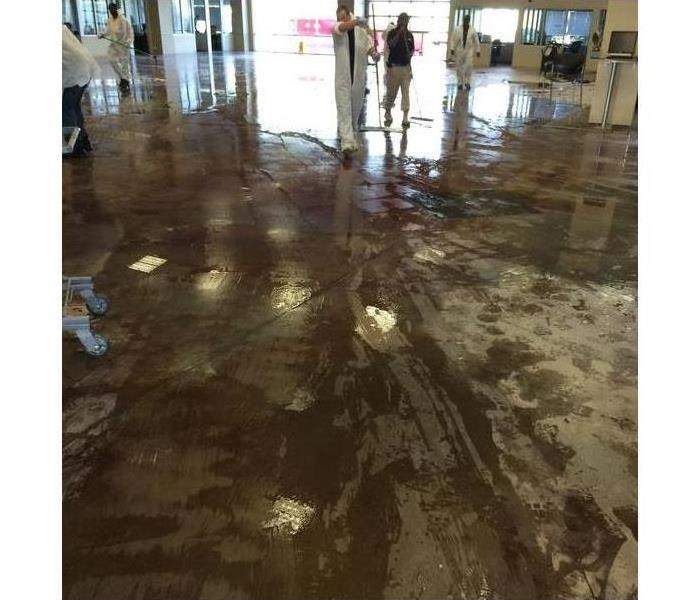 Flood damage in La Marque, TX.
Flood damage in La Marque, TX.
Running a business is challenging enough without having to worry about natural disasters. Still, business owners in La Marque, TX, must plan for flooding. After all, few things can bring a business to a standstill faster than a flood. Still, many business owners think they do not need independent flood insurance if they house their business in a rented building. That logic is misplaced. For a variety of reasons, purchasing renter’s insurance is usually a good idea.
Understanding Flooding
No business owner wants to watch floodwaters consume the workplace. Still, flooding is more common than you think. Floods occur in a variety of situations, including the following:
- Heavy rainfall
- Damaged dams
- Hurricanes
- Overflowing draining basins
- Melting snow and ice
Assuming Risk
Many business owners do not own the buildings that house their businesses. Even if the landlord has his or her own flood insurance, savvy business owners often choose to buy renter’s insurance. The rationale is simple. When a flood occurs, the landlord’s insurance policy generally covers structural damage to the building. This includes both interior and exterior damage. It does not, however, typically cover damage to the contents of the building. Without rental insurance, business owners are responsible for replacing equipment, inventory, computer systems and other business property.
Getting a Quote
Applying for both a renter’s and owner’s insurance policy is a similar process. Once you find a reputable insurer, expect to provide a list of business assets. After your agent determines your business’s flood risk, he or she can advise you on how much insurance your company should carry.
While renter’s insurance cannot eliminate the possibility of a flood occurring at your business, it can give you peace of mind. It can also help you cover the cost of a restoration service if your business ends up underwater. Either way, investing in independent flood insurance coverage is an effective strategy for protecting your business investment.
Is Your Home Flood Ready?
9/28/2021 (Permalink)
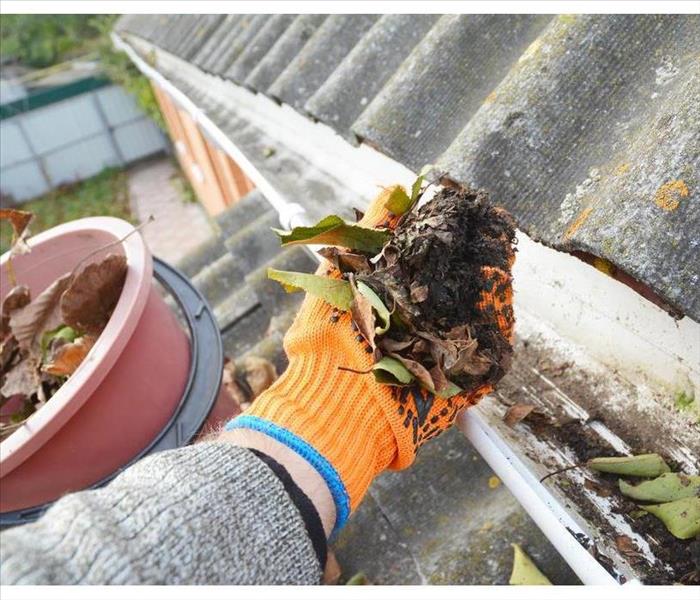 Keep your gutters clean.
Keep your gutters clean.
Is Your House Flood-Proof?
Whether a flood is imminent or you live on a flood plain and want to take preventative measures, you can prepare your home and minimize flood damage before it starts. Here are five ways to forestall flooding and storm damage.
1. Flooring Choices
If your home is situated on a flood plain, you may want to forego carpeting. Solid wood can tolerate water, but porous materials will sustain damage and need to be torn out and replaced. Standard home insurance policies do not cover floods, so you may wish to seek additional coverage through the National Flood Insurance Program.
2. Flood-Proofing Supplies
You may be able to limit the intrusion of flood waters with sandbags and plastic sheeting. Gather these materials and prepare to use them if you stay in your home during a flood.
3. Content Location
Try to elevate or relocate delicate contents such as electronics, files, furniture, or other valuables to dry locations. This may help to limit the extent of restoration necessary in the wake of flooding.
4. Utility Disconnection
You may want to turn off the supply of water and gas to your home. You can either shut off electricity to the damaged areas of your house with circuit breakers and fuses or shut off all power to your home. Also, plugging drains can prevent sewage backup and regulate the pressure in your basement.
5. Drainage Cleanout
If heavy rains are expected to contribute to a flood, make sure that your drainage system is clear and will direct water away from the foundation of your home. This includes gutters.
These tips can limit the extent of flood damage when flooding is anticipated in Dickson, TX. If you are dealing with water or storm damage after a flood, contact a company that specializes in residential damage restoration.
How Your Solar Panels Will Stand up to a Storm
7/27/2021 (Permalink)
 Solar panel on a roof.
Solar panel on a roof.
How Will Your Solar Panels Survive a Storm?
Have you decided to join the many others in Nassau Bay, TX, and have gotten solar panels on your roof? These panels provide many benefits, including an environmentally friendly way to generate power in your home. These panels are effective, but you may worry about how they’ll stand up to adverse weather. Rest assured that they will continue to do their job and withstand panel damage in just about every weather condition. Here are a few weather situations you may be concerned about.
High Winds
If hurricane-force winds hit your home, there may be some significant roof damage. However, manufacturers put solar panels through thorough and rugged testing to ensure they will hold up in even the strongest of winds. In fact, you may be surprised at how secure the panels are once they are attached to your roof. Here are some surprising facts about solar panels and high winds:
- Most panels are certified to sustain winds up to 140 mph.
- Most panels will operate at peak efficiency following hurricanes.
- During the strongest storms, even if there is damage to the panels, you will probably only lose a few.
Hail
Likewise, when manufacturers build solar panels, they use the strongest, most durable materials to withstand hailstones. In fact, most manufacturers test the panels to continue to work even if stones 1 inch in diameter hit them at up to 50 mph. It is possible for the panels to break but ordinarily only if large hailstones repeatedly hit the same spot.
Rain
Large storms will also bring significant rain. Though this might threaten weak roofs, you shouldn’t have to worry about panel damage. Not only will the precipitation not cause harm to the panels, but the solar panels themselves should continue to function properly even during heavy rainstorms. During the daytime hours and when the sunlight shines, your panels should gather enough solar energy to power your home when darkness comes and when rain falls.
Winter Safety Tips for Business Owners
6/9/2021 (Permalink)
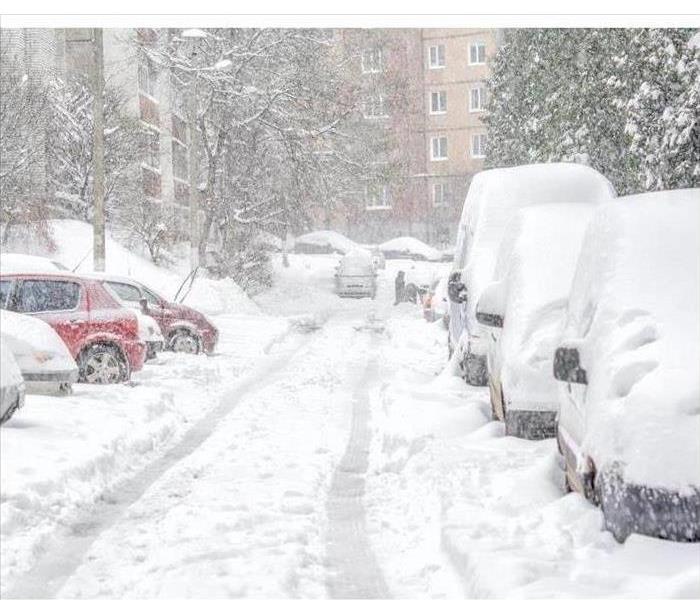 Winter storm in Clear Lake, TX.
Winter storm in Clear Lake, TX.
For business owners in colder climates, winter storms inevitably affect your company and staff in one way or another once the temperature starts to drop. Whether it's freezing rain, a snowstorm, or bitter cold, you don't need to let Mother Nature disrupt you every time she sees fit to throw a little weather your way. Following a few simple tips will prepare you and your employees for the next storm and keep you up, running, and safe until blue skies return.
Know Your Storm Warnings
There are a few key terms weather forecasters use to alert the public that a winter storm may be headed to the area:
- Winter Weather Advisory
- An advisory is issued when imminent sleet, freezing rain, or snow is predicted at 80% or more probability of affecting the area. These conditions could pose serious inconveniences or harm if caution isn't taken.
Winter Storm Watch
12 to 48 hours before a winter storm is predicted to hit the area, forecasters issue a watch that heavy sleet, freezing rain, snow, or even a blizzard, is possible. These conditions pose extreme danger.
Winter Storm Warning
12-24 hours ahead of a storm (or when a snowstorm is actually underway), a winter storm warning is issued to alert the public of the likelihood that heavy sleet, freezing rain, snow, or a blizzard is imminent. Extreme caution should be taken to protect lives and property.
Use Caution That Matches the Forecast
To keep your property and building safe, consider taking these precautions:
To avoid damage and interruption from a pipe burst due to freezing, make sure to leave a tiny stream of water running when temperatures drop below 20 degrees.
Keep an eye on the news ahead of an impending storm. If road conditions are poor, consider allowing your employees to work from home if possible.
Before winter, ensure tree branches are cut back from your building to prevent damage if they break under the weight of snow or ice.
Have the number of a storm damage service in Clear Lake, TX accessible in case the worst happens.
Though meteorologists can't accurately predict every weather condition you may experience, they usually can give warnings of the possibility of a snowstorm in enough time to act. Have an emergency plan in place before it hits can potentially save your building, your business, and your employees' lives.
Does My Commercial Insurance Policy Cover Floods and Hurricanes?
4/8/2021 (Permalink)
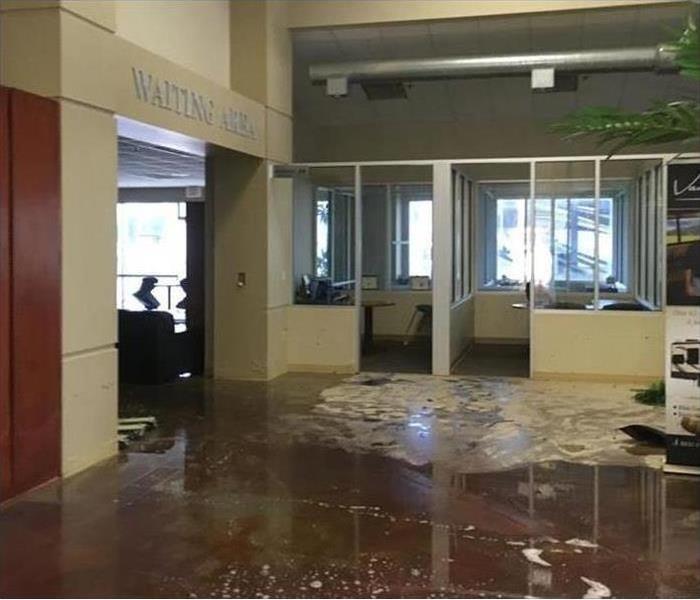 Storm damage in dealership in Dickson, TX.
Storm damage in dealership in Dickson, TX.
Different Types Of Storm Insurance
Business owners in Dickson, TX, might think their commercial insurance covers damage from hurricanes and floods. In many cases, though, you need to purchase separate coverage. Here are a few types of damage for which you may need separate storm insurance.
Hurricane Damage
This type of insurance coverage is currently a mandatory deductible in 19 states and the District of Columbia. It is a percentage deductible based on the value of your property. The cost of this coverage varies depending on your provider and where your property is located in relation to the coastline.
Hurricane insurance typically covers your building or structure and its contents for cleanup and storm damage restoration, including:
- Inventory
- Computers
- Electronic equipment
- Furniture
- Fixtures
- Cargo
Check your policy to see if passenger vehicles and machinery are included. Often, you need a separate policy to cover these items.
Wind and Hail Damage
Insurance coverage for hail and wind damage is included in standard property insurance for most of the country. In coastal areas, business owners may need to purchase separate storm insurance for these types of perils. Wind and hail damage may be covered under a hurricane policy.
Flood Damage
Damage from flooding is different from hurricane damage. In many cases, the damage caused by hurricanes results from storm surge and rising water. When damage results from water on the ground, it is considered flood damage.
You can purchase flood insurance through the National Flood Insurance Program, or NFIP. The program is managed by FEMA and offers insurance in participating communities through a network of companies.
If your business is in a high-risk flood area and has a mortgage through a government-backed lender, you must have flood insurance coverage.
It's best to review your policy from time to time to ensure you have the right storm insurance for the types of perils that can happen to your Dickson, TX, business.
4 Tips To Keep Your Sump Pump in Good Shape
1/14/2021 (Permalink)
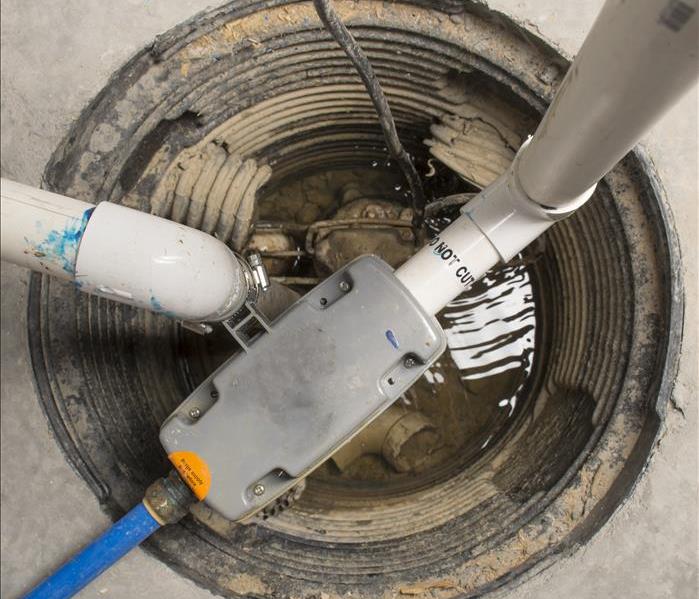 Keep your pump in good shape
Keep your pump in good shape
4 Tips To Keep Your Sump Pump in Good Shape
Spring can be a wet time of year in Clear Lake, TX. If you rely on a sump pump to keep your building dry, now is a good time to be sure you’re up to date on any necessary pump maintenance and that your pump is in good working order. These tips can ensure that your pump is up to the task when wet weather arrives.
1. Test Your Pump
To test your pump, pour water into the pit until the float triggers the pump. Ideally, the pump should kick on and empty all water from the pit within a few seconds, then shut off. If the process is slow or fails, you may have to repair or replace some parts of your pump.
2. Add an Alarm
Tank level alarms are designed to alert you if your pump stops working or if water reaches a certain level within the pit. Some pump alarms make an audible alarm sound. Others are equipped with smart technology and will send you a text or email alert if the sump pump fails.
3. Consider a Backup
If you’ll frequently be away from your building, you may not always be available if your pump fails or if the building loses power. In that case, a backup pump would be a wise investment. Choose a pump that runs on a marine-grade battery or opt for a pump that is powered by water pressure.
4. Clean the Pit
Be sure to clean out your sump pit regularly. Use a wet/dry vacuum to remove any gravel, dirt, or other debris, as these can clog your system and cause unnecessary wear and tear to your pump.
Don’t wait until your pump fails to perform basic maintenance. Avoid flooding and costly water damage restoration by making sure your sump pump is in good working order before the rainy season starts.
Storm Preparedness for Property Managers
11/10/2020 (Permalink)
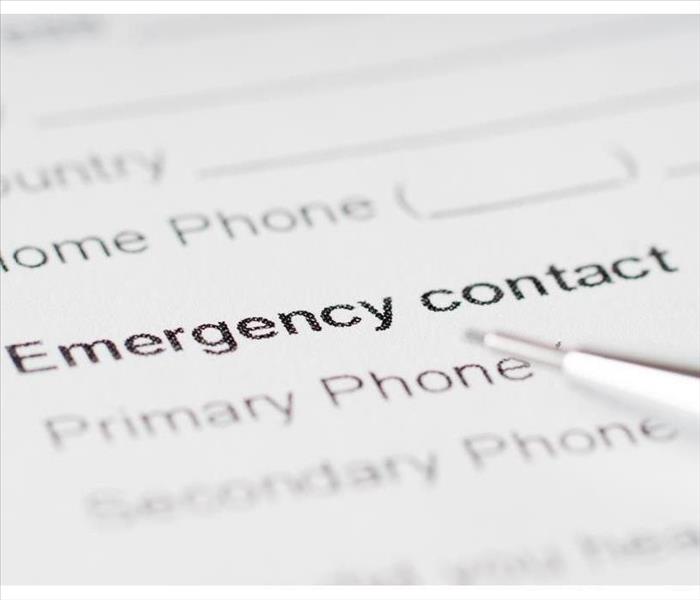 Part of your plan needs to incorporate an emergency contact list
Part of your plan needs to incorporate an emergency contact list
Storm Preparedness
As a property manager, you have a lot of responsibilities to tend to in the event of an approaching storm. While keeping your property and other personal possessions is important, your first priority is keeping your residents and employees safe. Storm preparedness is key to keeping your La Marque, TX, property and residents safe during severe weather.
Plan Ahead of Time
You need to create an emergency weather plan before disaster strikes. Part of your plan needs to incorporate an emergency contact list that contains that following essential information:
- Full names for all property residents
- Number of residents in each apartment, including small children, special needs residents and the elderly
- Contact information for each resident, including home, work and cell phone numbers
- Number of pets residing in each apartment
Work with the remainder of your property management team to distribute the emergency storm preparedness plan to all of your residents. Practice this protocol regularly with your employees to help reduce unnecessary panic once disaster does strike. Make sure everyone knows where the designated weather shelters are located, if necessary. Resident safety is your top priority, so make sure to do plenty of head counts to ensure everyone is present and accounted for.
Rebuild After the Storm
After the storm passes, you need to fully inspect your property for signs of storm damage. Record full reports of any damage you find, including photographs, when necessary. Pass this report on to the property owner so they can properly file a storm insurance claim. Lastly, communicate any updates regarding storm damage to your residents. They need to be aware of any potential safety hazards caused by strong rains and winds.
Proper storm preparedness can make a huge difference when it comes to protecting both your physical property and your residents. Make sure to contact storm remediation experts for assistance following a tropical storm or hurricane.
5 Things To Avoid During a Business Flood Cleanup
10/19/2020 (Permalink)
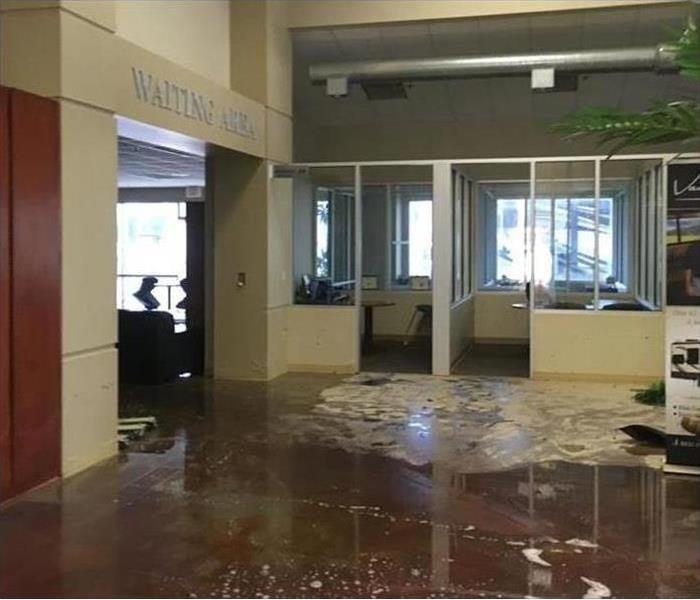 Storm damage in Dickson, TX
Storm damage in Dickson, TX
Here Are Five Things You May Want To Avoid Doing
After floodwater has affected your Dickson, TX home, you may be in need of a flood cleanup. During this process there are a number of things that will need to happen, but there are also a few mistakes that should be avoided.
1. Forgetting to Contact a Professional
Any time you have flooding in your business it’s important to contact a local water damage restoration service for help. Trying to clean everything yourself can be overwhelming. These professionals have a dedicated team with the proper equipment to help restore your business property as quickly as possible.
2. Not Removing the Water
Just like a flooded home, water left to sit in a business can cause a number of problems. Water can soak in and cause wood to swell, drywall to crumble, and tile or stone to crack. Standing water should be removed as quickly as possible.
3. Failing to Dry the Area
After the flood water is removed from the space it will need to be thoroughly dried. Forgetting to take this step could lead to delays in repairs, or problems with mold growth. A dehumidifier may help pull water from the air during this process.
4. Forgetting to Sanitize the Space
After the area is dried it was also need to be cleaned an sanitized before the water damage restoration can begin. Forgetting to take this step could leave behind bacteria which could cause problems down the road.
5. Not Using Safety Equipment
Forgetting to use safety equipment can lead to possible injuries during a cleanup. This is why it’s important to always wear the correct gear. This often includes masks, gloves, clothing covers, and shoe covers or work boots.
When dealing with floodwater in your business it’s a good idea to follow these guidelines in order to ensure the space is cleaned up properly. Remember to contact a professional, remove water from the space, dry the area, sanitize the area, and use the correct equipment. Forgetting to take these steps could potentially lead to more problems.
Understanding Mitigation vs. Restoration
9/8/2020 (Permalink)
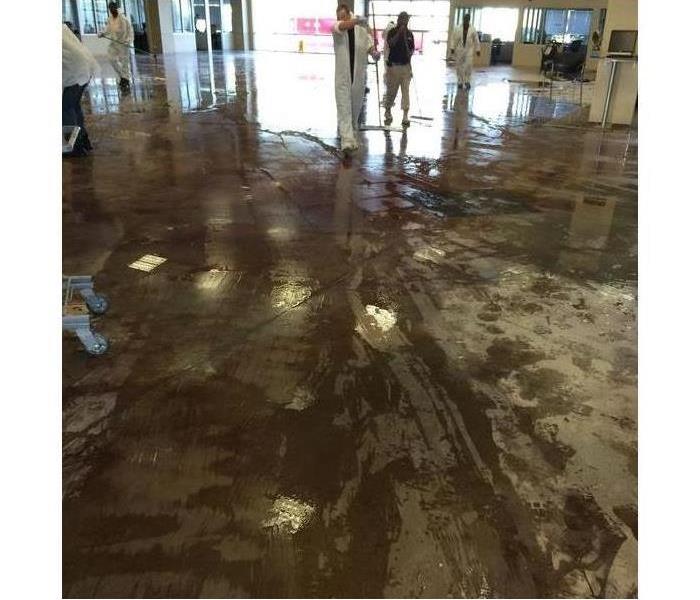 Storm mitigation in Dickson, TX
Storm mitigation in Dickson, TX
Two Basic Phases Of The Repair Process In Your Building
When your building is damaged by flooding after a storm in Dickson, TX, there are two basic phases of the repair process. A flood cleanup company must first mitigate the mess the storm left behind. Then the parts of your building that were destroyed must be restored.
Mitigation
Before any part of your building can be rebuilt, technicians first have to get debris and ruined materials out of the way. Once they have assessed the damage, there are several steps they take to mitigate it:
- Pump out excess water
- Repair or discard all affected items
- Tear out ruined materials
- Disinfect remaining surfaces
- Dry the structure
These steps must happen quickly in order to avoid problems that fall under the category of secondary damage. Mold growth, for example, can occur in as little as one day after disaster strikes. Quick mitigation by a certified flood cleanup company is the key to keeping damage to a minimum.
Restoration
The second phase of the repair process takes more time. After mitigation, the restoration company is likely left with the bare bones of your building. They start by adding new insulation and rebuilding walls. Then they install new ceiling tiles and flooring. To complicate matters, all these features must be matched to the remaining walls, ceilings, and floors so that it looks "Like it never even happened," when the restoration process is finished. Finally, the furniture, equipment, and inventory that was able to be saved must be moved back into the building. One way to speed this part of the process up a little is to find a mitigation company that also specializes in restoration. That way, you have one team that can work seamlessly from beginning to end.
When your building is damaged in a storm, the flood cleanup company may get through mitigation quickly, but restoration will likely take longer. Understanding how the process works can help set reasonable expectations.
Clear Lake Home Safety: How Fast Can Storm Damage Be Fixed?
9/1/2020 (Permalink)
How Fast Can Storm Damage Be Fixed?
The greater Houston metropolitan is known for its active theater and cultural district, the NASA complex, a thriving central business district, fine restaurants, and beautiful countryside. However, we are also known for our severe weather events.
Storms damage thousands of area homes each year, and the resulting cleanup and restoration process is often an overwhelming task for homeowners. That is why, from the first call to the insurance company through to the completion of your restoration, your Houston SERVPRO of Clear Lake asks you to partner with us in the process of getting back into your home.
One of the first questions you may ask our highly trained restoration specialists is “How fast can the storm damage be fixed?” The answer to that question depends on the four key factors:
1. Insurance Company and Homeowner Approval of Restoration Plan. Before we can begin working on your home, you and your insurance company need to approve and sign our work contract. This contract will detail the work to be done, a timeframe, and the budget. The sooner we can come to acceptable terms, the more quickly work can begin.
2. Severity and Scope of Damage. If the recommended course of action is an only a thorough cleaning, disinfecting, and dehumidifying of your home and belongings, the water damage was likely minor and can be fixed quickly. However, if best practices and health codes indicate that drywall, insulation and carpets need to be removed and replaced, the process will take considerably longer. Likewise, if only a couple of rooms in your home were damaged, the restoration process will obviously be much quicker than if the entire home was damaged by floodwaters.
3. Availability of Contractors. In the event of a widespread natural disaster where many homes and businesses are damaged, reliable contractors quickly become booked, sometimes for many months to come. That is why it is imperative you contact your locally owned and operated Houston SERVPRO without delay. SERVPRO's Disaster Recovery Team mobilizes quickly after a natural disaster to set up local command centers and increase our resources and manpower; no one surpasses our readiness to help our friends, neighbors, and members of the greater Houston area community.
4. Infrastructure Damage. After a devastating natural disaster, the infrastructure of a city— including roads and utilities—can take several weeks to be brought back online, and this can delay the restoration process. In the first few days after a historic weather event, it is sometimes difficult for our technicians and specialists to move around the area. However, you can rest assured that we are doing the best we can start rebuilding our community and your home. Damage to roads may cause a delay in the arrival of building supplies, so we ask that our customers remain patient, while we remain vigilant in getting the project done safely and done right.
Recovering from flood, hurricane, tornado, or other severe weather event does take time, but as members of the community, we understand how important it is to our customers to get back into their homes after disaster strikes. Call on us anytime your home is damaged; we are available 24 hours a day to respond, and will begin storm damage restoration work as quickly as possible.
3 Ways Storm Damage Can Affect Your Business
8/5/2020 (Permalink)
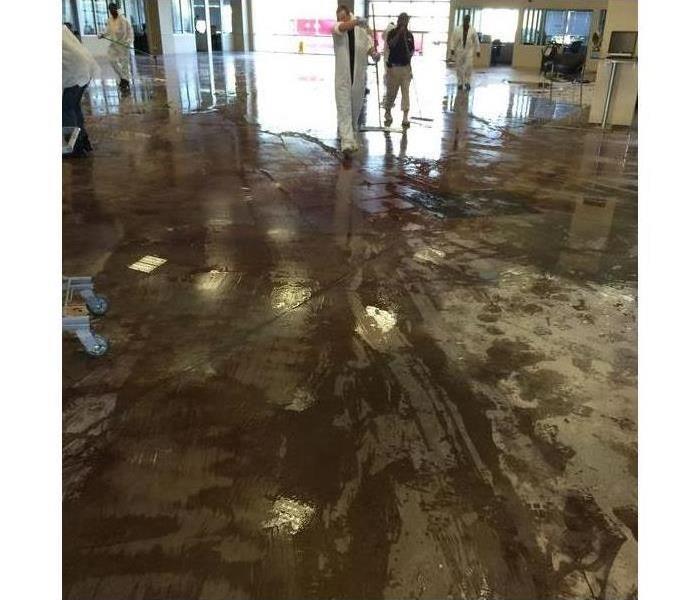 Storm restoration in Nassau Bay, TX
Storm restoration in Nassau Bay, TX
3 Ways Storm Damage Can Affect Your Business
After a storm in Nassau Bay, TX, there are a few ways your business may be affected. Contacting a local storm damage restoration service can be one way to ensure these problems are fixed before long term damage occurs. Here’s what you may want to know about roof damage, flooding, and mold problems.
1. Roof Damage
It’s important to note that flood damage can also occur to the roof. This can happen when a block in the gutters or drainage system causes water to overflow. This water can back up onto the roof and flood the space. If left unattended it can seep in and cause damage. Other forms of roof damage can come from hail beating on the surface, or strong winds which can know roofing and gutters lose if not properly secured.
2. Flooded Areas
One of the first thoughts, when one hears about a large storm, is to consider the risk for a flood. Flooding can occur if there is a leak or other space, like an open window, which can allow water into the building. Additional risk factors include land sloped in a way that allows water to pool against the building and debris which can be blown into the structure cracking a window or damaging another weakened location.
3. Mold Problems
Another problem, water damage could lead to is mold. Mold grows best in dim moist climates meaning that water damage can create a habitat for the fungi. Water soaks into organic material softening it for the mold spores to consume, and also keep the area humid. Restoration professionals know to look for this problem and in many cases are also trained for mold remediation. Meaning you shouldn’t need to contact a second service if mold does occur.
After a storm Roof damage, flooding, and mold problems may all occur. This is why it’s important to contact a restoration service quickly so that these issues can be found and fixed before long term damages affect your business.
How Property Managers Should Prepare for a Storm
3/30/2020 (Permalink)
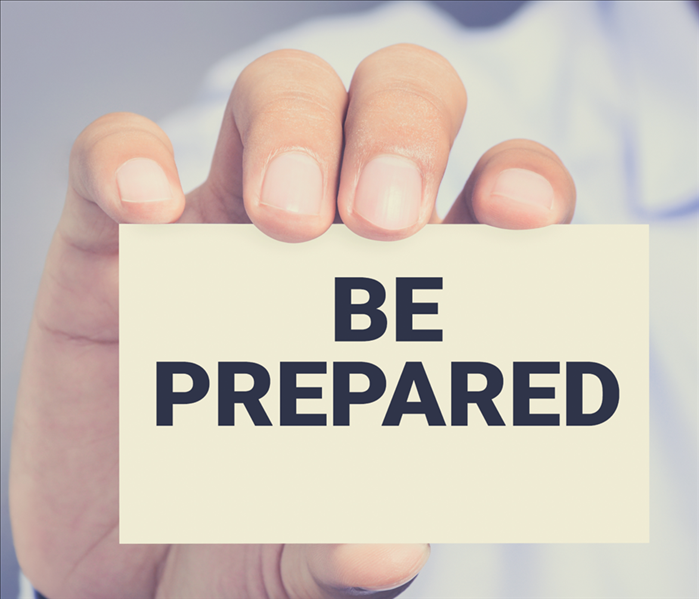 Be prepared and keep your building and your employees safe
Be prepared and keep your building and your employees safe
As a property manager, you know that thorough storm preparedness is a key part of your job. If you find out that a hurricane or tornado is approaching your commercial building in Dickson, TX, you must take steps to prevent major flood damage. There are things you can do before, during and after the storm to make sure your building is ready.
Before the Storm
Before storm season even arrives, draw up a playbook that describes everything you will need during an emergency. Your playbook should include these items:
- Addresses and phone numbers of your staff members
- Emergency contacts for your employees
- Roles each employee will play during a storm
- List of essential personnel
Be sure to review the storm preparedness playbook with your staff well in advance. This way, they will know what to do before the storm hits. You should also work with the owner of the premises to ensure all the businesses in your building are informed about any upcoming storm.
Finally, review your insurance policy ahead of time. Make sure that your insurer covers the cost of flood cleanup.
During the Storm
As an impending storm gets closer, you should go over the plan again with your staff. Tell your nonessential employees that they can work from home. Essential workers, including front desk clerks and engineers, should stay on site until it is no longer safe for them to do so. Before the employees leave the premises, make sure that they know who to contact for updates.
After the Storm
Once the tornado or hurricane has passed, you and your maintenance supervisors should inspect the premises for storm damage. Be sure to take photos and videos to show to the building owner. You can then call storm cleanup specialists for assistance with the restoration.
Property management can be difficult during hurricane and tornado season. With a proper storm preparedness plan, you can help keep your building and your employees safe.
The Best Options for Cleaning a Sewage Backup
11/13/2019 (Permalink)
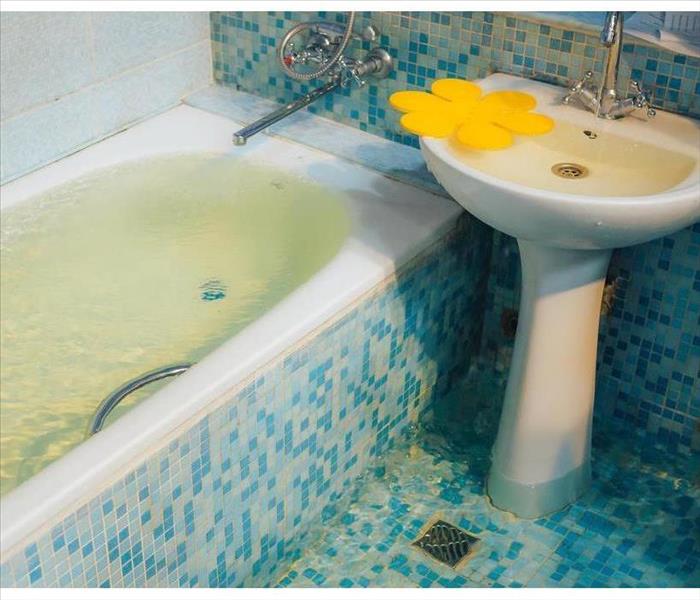 Sewer back up in La Marque,TX bathroom
Sewer back up in La Marque,TX bathroom
There is never a good time for a sewer backup in your home. More than likely, one will occur at the end of the day or during a holiday weekend. Still, as a homeowner, when a backup occurs in La Marque,TX, it demands your full attention. You may wonder what steps you can take on your own, or with the help of your family members, and what steps require the services of a professional water cleanup service. A basic understanding of what you are dealing with is a good starting point. Contaminated water, sometimes known as black water, has the potential to be harmful to human health and should be approached with caution.
Steps To Take on Your Own
It pays to know your limitations when dealing with a sewer backup, but there are several things you can do once the problem is discovered. It is important to know that a bathtub backup may also contain sewer water. The following are a few reasonable and safe steps to take at once:
- Make a quick call to a cleanup team
- Alert all members to the presence of contaminated water
- Shut off water lines that are easily accessible
- Turn off electrical power that may be impacted by moisture
- Keep pets out of contaminated areas
- Move uncontaminated items away from the area.
It's vital to note that flooding can introduce black water to the property. Flood waters should be treated as potentially hazardous.
Steps To Leave to the Professionals
Any contact with the actual contaminated water or tainted items should be handled by trained workers with personal protective equipment. The cleanup crew can provide a quick inspection and damage assessment and inform you of what needs to be done. Specialized equipment such as sump pumps, wet vacs, industrial fans, ventilators and more will speed up the cleaning process and help your home recover from a sewer backup.
Storm Preparedness Is a Key Role for Property Managers
10/24/2019 (Permalink)
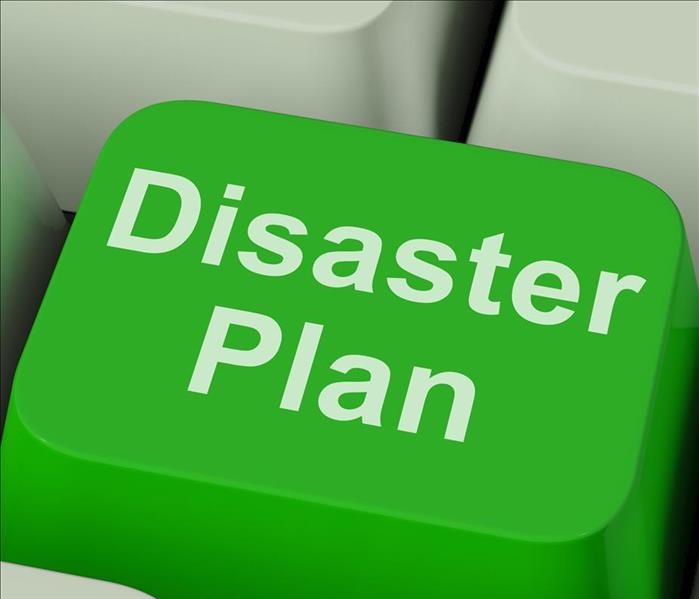 Develop a disaster plan that outlines critical equipment, building materials and evacuation routes
Develop a disaster plan that outlines critical equipment, building materials and evacuation routes
As a property manager, your location in Clear Lake,TX, determines to a large extent the types of storms you will face. This fact can help you with your storm preparedness, an increasingly important role for anyone who owns or is responsible for a large business. The effects of powerful storms such as hurricanes, tornadoes and torrential rains are legendary. Storms can blow off roofs, topple buildings and flood interiors. While it's impossible to be prepared for every scenario, a bit of planning has many benefits. It can save lives, reduce damage and speed up the recovery process. One essential role of planning is to partner with a storm mitigation team that can get to your site quickly after a storm passes through. Rapid damage assessment and water removal are keys to getting your company moving in the right direction.
Tips for Storm Preparedness
The property management team should follow a standardized blueprint for effective preparation. The key items to concentrate on include the following actions:
- Create a storm playbook with emergency contacts
- Educate employees about their roles in a storm
- Develop a disaster plan that outlines critical equipment, building materials and evacuation routes
- Pay attention to those with special needs
- Review insurance policies to make sure they are current
- Back up intellectual assets on hard drive or keep in waterproof safes
Owners and property managers may wish to stay with the building as long as possible; however, if a mandatory evacuation is ordered everyone should leave in a safe and orderly fashion.
Keys for Recovery
A good disaster plan looks ahead to the recovery phase. This includes calling in maintenance personnel, water remediation professionals and insurance agents. In addition to an assessment of property damage, it's important to inventory damage to intellectual assets such as files and records. When things settle down, this is a good time to review your storm preparedness success, and to look for improvement for the future.
3 Wind Damage Mitigation Steps You Should Know
9/3/2019 (Permalink)
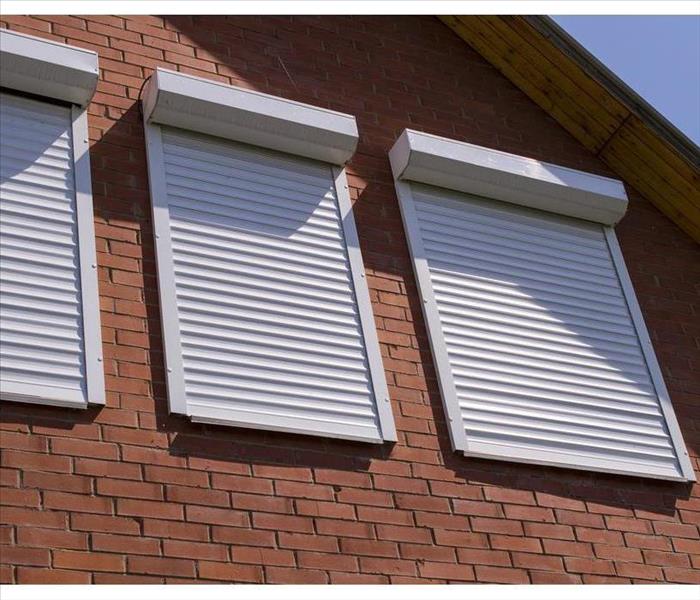 Install storm shutters in your building for protection
Install storm shutters in your building for protection
Ways To Protect Your Business From Wind Damage
One of the problems a storm can be with it in La Marque,TX, Is wind damage which may lead to a number of problems including a roof leak, debris, loose siding or shingles, and torn up landscaping. Fortunately, there are several steps you can take to protect your business property.
1. Think About Movable Debris
A damaged roof may not be the only problem you can experience with high storm winds. It's also wise to consider any debris that can be picked up and thrown into the property. This may include falling branches, loose sticks and rocks, sand or mulching, and other similar materials. You may want to trim the trees around the property, and install storm shutters protect anything that could hit the windows.
2. Protect At-risk Areas
You may also want to take some time to protect any at-risk areas on the business property. This may include placing tarps or boards to protect your shingles from a roof leak, creating barriers against flooding around the landscaping, inspecting any drainage for clogs, or installing helpful tools such as storm shutters or a sump pump.
3. Call a Professional
Another step you can take is to make any repairs as quickly as possible. In many cases your best bet will be to contact a professional. Particularly a storm damage restoration service. A professional will know what sort of damage to look for on your roof, how to take care of missing shingles and other damages they may find, and what sorts of roof damage to help you protect against in the future.
When expecting a storm you can take several mitigation steps including installing shutters to protect property, placing protective tarping on the roof to prevent a roof leak, and talking to a local professional quickly about any damage that has occurred. Acting quickly can help prevent further damage in the long-term, and help you get your business back to working condition.
2019 Atlantic Hurricane Names Released
7/16/2019 (Permalink)
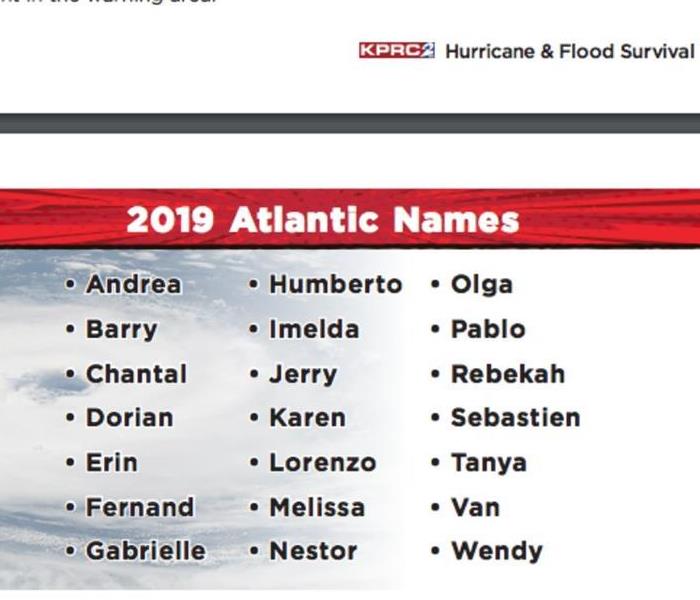 2019 Atlantic Storm Names
2019 Atlantic Storm Names
Do you ever wonder why hurricanes are named? It stared off in the mid 1900's when meteorologists realized that the general public cared much more, and payed attention to, storms that were given names.
It makes it easier to reference one storm over another. In the beginning the U.S. National Hurricane Center started naming storms in the early 1950's, but now the task has been handed to the World Meteorological Organization.
So when does a storm receive a name? Tropical storms are given names when they display a rotating circulation pattern and have wind speeds of 39 MPH. If a tropical storm increases to a hurricane they keep their same name. Smaller storms including tropical depressions do not receive names.
Here are the 2019 hurricane names for the Atlantic hurricane season:
- Andrea
- Barry
- Chantal
- Dorian
- Erin
- Fernand
- Gabrielle
- Humberto
- Imelda
- Jerry
- Karen
- Lorenzo
- Melissa
- Nestor
- Olga
- Pablo
- Rebekah
- Sebastien
- Tanya
- Van
- Wendy
Our Recovery Efforts During Hurricane Florence
5/6/2019 (Permalink)
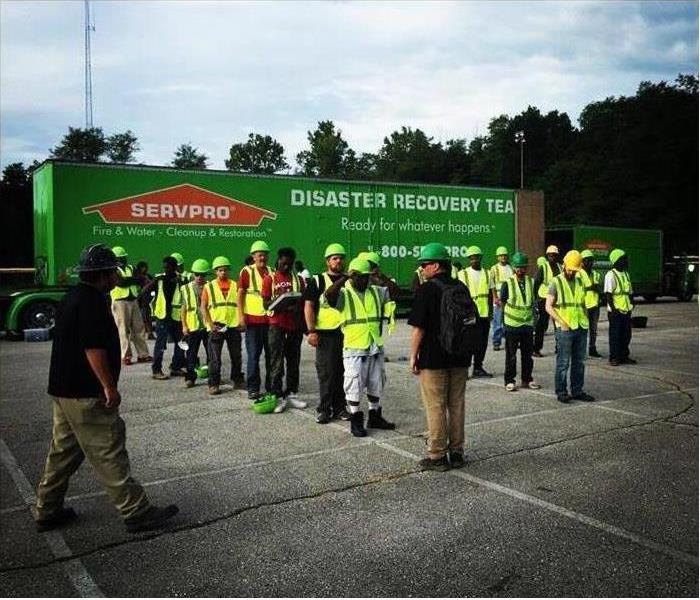 SERVPRO of Clear Lake on the scene during the storm disaster
SERVPRO of Clear Lake on the scene during the storm disaster
In September of 2018, Hurricane Florence swept through the Carolinas causing catastrophic damage. The powerful hurricane caused 20 to 30 inches of rainfall which resulted in life-threatening flooding.
During this difficult time, SERVPRO of Clear Lake was there to offer our assistance and service. We traveled the streets of North Carolina restoring and mitigating all water damages. In many cases, we moved the victim’s belongings and furniture out of the home and then performed full demolition on the property. The demo consisted of removing baseboards, shoe mold and drywall. Additionally, due to heavy odors, several carpets and padding were removed. Lastly, we left multiple pieces of specialized equipment such as air movers and dehumidifiers to ensure all properties were fully dry.
When there's a storm, SERVPRO of Clear Lake promises to be faster to any size disaster. You can rely on us to always provide excellent immediate service to all of our clients.
Clear Lake Home Health: Cleanup Right After a Storm
12/7/2018 (Permalink)
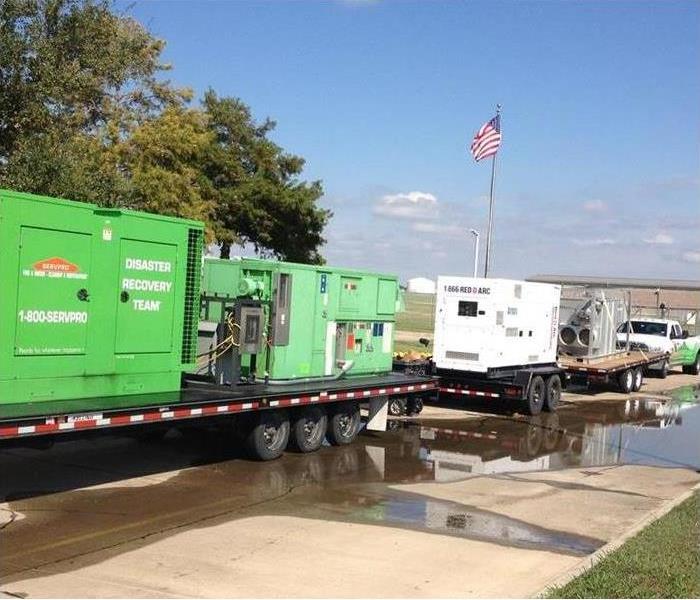 SERVPRO Storm Fact: No Job Is Too Large!!
SERVPRO Storm Fact: No Job Is Too Large!!
Cleanup Right After a Storm
Severe weather in the greater Houston metropolitan area often bring rising waters, and floods that affect thousands of properties throughout our community. In addition to the mud, sludge, and debris, flood waters can be contaminated with sewage, and even bring snakes, insects, and other critters. Flooding can present a challenge for property owners – risk safety and health to do the cleanup themselves or contact a water damage restoration company. Without proper cleanup, many homes and business will require mold removal in Clear Lake, and the surrounding communities.
While clean water from broken water pipes, a leaky roof, or even a leaking dishwasher, can be safely mopped up, special care needs to be taken with floodwaters. The bacteria and microbes, not to mention the snakes, rodents, and debris can cause health concerns. Professionals recommended that individuals entering floodwaters have proper protective clothing, footwear, and eye protection. Traumatic puncture wounds due to sharp debris can occur. Take every precaution to keep yourself, and your family safe.
When the water recedes, the prospect of cleaning up after the storm is overwhelming, even for the most prepared. Furniture, personal items, drywall, floors, and the structure of the property must be evaluated for damage, and the water damage cleanup should begin immediately. Depending on the level of contaminants in the floodwater and how long the water remained on the property, will determine in part, the level of water damage to your home. Saturated drywall will often need to be removed; however, many other items including carpets, furniture, and draperies may be able to be cleaned and restored to their pre-flood state.
SERVPRO of Clear Lake has the tools, training, and expertise necessary to restore your property to its original state. Locally owned, and operated, our team is available 24 hours a day, whenever disaster strikes. Trust us to clean up your property after a storm, fire, or other event to help ensure that a mold infestation doesn’t take root in your home. Our climate, particularly after a severe storm, supports rapid mold growth. It is essential that your property is properly cleansed, and dried, prior to restoration. Often, our remediation team finds mold infestations due to improper flood and storm damage cleanup.
SERVPRO is faster to any size disaster, and we have the resources to respond quickly, regardless of the size of the event. Our disaster recovery teams stand at the ready to help homeowners and commercial property owners mitigate the damage caused by floods, storms, sewage backups, fires, and other events. We will start immediately by assessing the damage, removing the water, drying and dehumidifying, cleaning and repairing, and completing the restoration, so you and your family can resume life as quickly as possible. Call us today for any water damage or mold removal needs in Clear Lake, and throughout the greater Houston area.
Clear Lake Home Health: Step-By-Step Guide to DIY Flood Cleanup
12/7/2018 (Permalink)
 Floods are among the most frequent and costly natural disasters.
Floods are among the most frequent and costly natural disasters.
The recent floods in the Houston metropolitan area have devastated countless homes and businesses throughout our community. SERVPRO of Clear Lake stands at the ready to assist you throughout the flood cleanup process, from water extraction to restoration. However, if you prefer to do the cleanup yourself, use these steps.
1. Make Sure Property is Safe to Enter. Appliances in standing water can present dangerous electrical hazards. Check with your local authorities or utility companies to ensure that electricity and gas have been shut off.
2. Wear Protective Clothing. Floodwaters carry sharp debris, sewage, bacteria, chemicals, and even wildlife. It is important to don sturdy work boots, long-sleeved shirts, heavy jeans, rubber gloves, and protective eyewear.
3. Document the Damage. When it is safe to enter the property and you are wearing protective clothing, take photos and video of each room to document the damage.
4. Call Your Insurance Company. When widespread natural disaster strikes, insurance companies often deploy extra team members to assist with the claim process. The sooner you call, the better.
5. Open Windows. To speed-up the drying process and improve the air quality in your home, open all the windows and doors in the home, weather permitting.
6. Extract Standing Water. With a wet/dry vacuum, extract as much standing water as possible from your home. If power is still off, use a generator to provide power to the vacuum.
7. Remove Furnishings and Appliances. Once the water is extracted, remove all furniture and appliances from your home. Homeowners in Clear Lake with water damage should place items outside to allow greater airflow within the home.
8. Remove and Secure Personal Items for Restoration. Move all personal items including photographs, jewelry, important papers, and other keepsakes to a dry, safe space. Your local Clear Lake SERVPRO team can restore flood damaged photos and other valuables. Call us for more information.
9. Setup Strong Fans. The sooner you can deploy fans to help dry your home, the better chance you have to prevent mold growth. In the Clear Lake area, mold starts to develop in as little as 48 hours of the water damage.
10. Cut Drywall. Drywall that has been saturated by floodwaters must be removed. Use a reciprocating saw to cut 6 inches above the water line being careful to avoid the electrical wiring and pipes that could be behind the wall. Remove any insulation, and dispose of it along with the damaged drywall.
11. Remove Carpet. Since flood waters can carry potentially hazardous chemicals and bacteria, the carpet and padding must be removed. Cut carpet into strips, 3 feet wide, and roll up for disposal.
12. Disinfect Hard Surfaces. Using a combination of bleach and warm water, scrub every surface in the home. This includes all floors, countertops, cabinetry, and remaining walls.
13. Apply Mold Inhibitors. Since mold develops so quickly in our area, it is important to treat all areas additionally with a mold inhibitor. While this does not guarantee complete mold growth prevention, it can be an effective deterrent.
14.Begin Reconstruction. Before beginning the restoration process, it is essential that your home has been thoroughly disinfected and dried. Use industrial fans and dehumidifiers for several days to allow humidity levels to fall. Remember, any electrical wires and outlets that were subjected to standing water will need to be replaced. Call a licensed electrician to complete this step.
When electrical work is complete, replace insulation and drywall. Follow with texture, prime and paint. This is also the time to replace carpet and wood floors that were damaged in the flood. The reconstruction process can take weeks, or months, depending on the amount of time you have to devote to it.
Be mindful that the longer water stands in your home, the more extensive the damage will be. Start the cleanup process as soon as it is safe to do so. If at any time you become overwhelmed, give us a call; we are happy to help you quickly get your home back to pre-flood condition.
If a Storm Cancels Your Flight
7/23/2018 (Permalink)
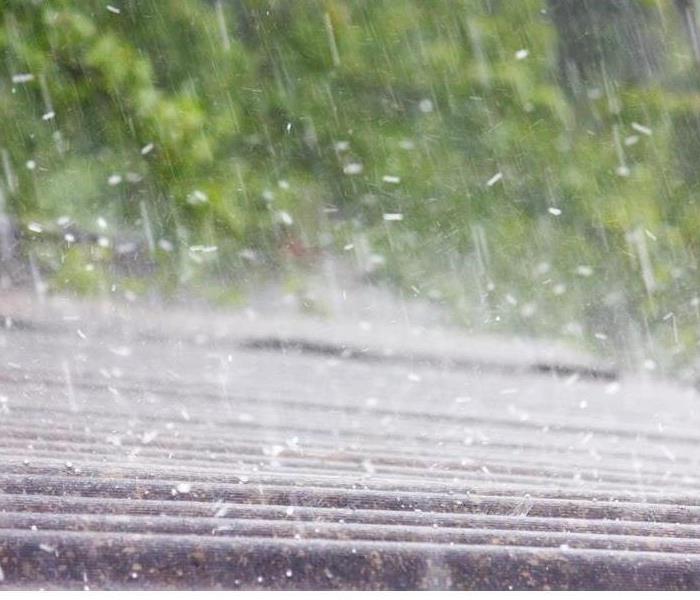
Coping with the fallout of storms can be a nuisance whether you are at home or on the road. Seasoned travelers flying to or from Clear Lake, TX understand that a weather delay or a canceled flight is always a possibility. However, they also understand that there are proactive and reactive moves to be made when Mother Nature interferes with the best-laid travel plans.
Proactive Moves
Wise travelers have learned the ins and outs of air travel. Sometimes the best defense is a good offense.
• Stay informed about the weather forecasts for your points of departure and arrival.
• If at all possible, avoid travel when inclement weather is predicted.
• Try to book direct flights to avoid layover cities where weather can factor into your connection’s timeliness.
• Leave early to avoid traffic and airport security delays even if your flight is running late.
• Pack lightly and carry your bag on the plane; retrieving checked baggage can be complicated if your flight changes.
Reactive Moves
If your flight is canceled and following proactive storm tips hasn’t helped, don’t despair. There are a few ways to bounce back from a canceled flight.
• Call the airline as opposed to lining up at the airline’s service desk in the airport. You will be served more quickly over the phone.
• Make the most of what airlines are willing to offer. Ask them to help you rebook or reimburse you for a connecting flight.
• Ask for reimbursement for food or lodging if the delay is substantial.
• Ask for reimbursement for a rental car if driving is an option.
• Don’t lose your cool. Calm and persistent customers have more success in getting what they want than those who display anger.
The airline is not required to compensate you unless it bumps you because it oversold the flight. For a canceled flight due to a storm, you are simply rebooked. Visit http://www.SERVPROclearlake.com/ for more information on storm damage.
Tips for Maintaining the Roof on Your Commercial Building
6/17/2018 (Permalink)
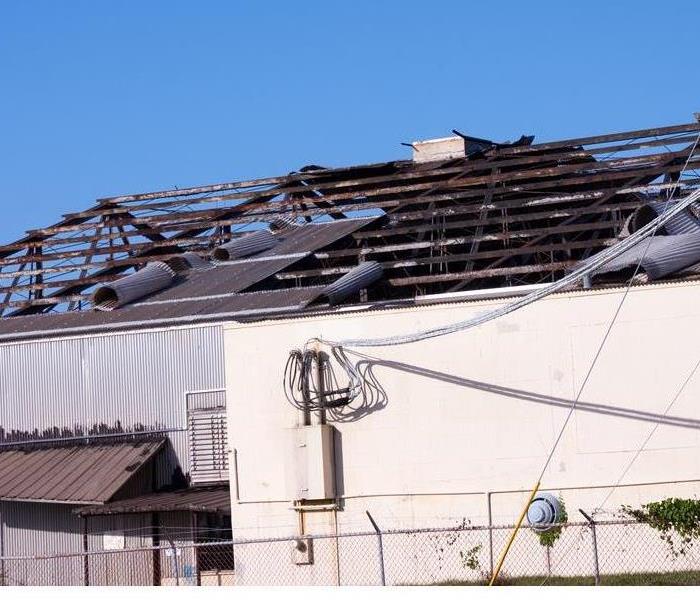
Your commercial building is an investment in your future, and as such, you need to invest in it. Though there are several maintenance measures that you need to be aware of, by far one of the greatest is roof maintenance. Your roof is your building's most vulnerable component, yet, it is also one of the most important. Your roof protects your building's assets from the elements, which is why you should invest in bi-annual inspections and measures to prevent a roof leak or other issue. In addition to annual inspections, there are other measures you can implement to keep your roof in great condition:
• Check the drains.
• Remove all debris from the rooftop.
• Inspect the gutters.
• Check for holes, leaks, mechanical abuse and other issues.
• Trim back any trees that overhang your roof.
• Make sure sealant and caulking are still intact.
Have a Plan in Place
In addition to knowing what you need to do to maintain your roof, you should also have a thorough and written plan in place. A properly written plan—and a way in which to execute it—can extend the life of your roof by years. Your plan should identify how to catch failures, such as a roof leak, and areas of despair early on, and before they become major and costly issues. Your plan should also leave an area in which you can note roof maintenance efforts, that way you can visually see which repairs have been made, and which areas still need attention.
Hire a Professional
Do not attempt to inspect and repair your roof on your own. Whether dealing with a leak or detached shutters due to wind damage, hire a Clear Lake, TX professional roofer to perform both inspections and repairs. Not only does a professional know what to do in each given situation, but a professional also knows which signs of disrepair to look for. Additionally, a professional roofer has all the right safety equipment and training.
Whether you're dealing with a roof leak or simply want to make sure that your roof is in good condition, call a professional to lend a helping hand. A properly maintained roof can prevent structural damage and the possible need for further remediation efforts. Visit http://www.SERVPROclearlake.com/ for more information on storm damage.
Tips for After the Flood
4/11/2018 (Permalink)
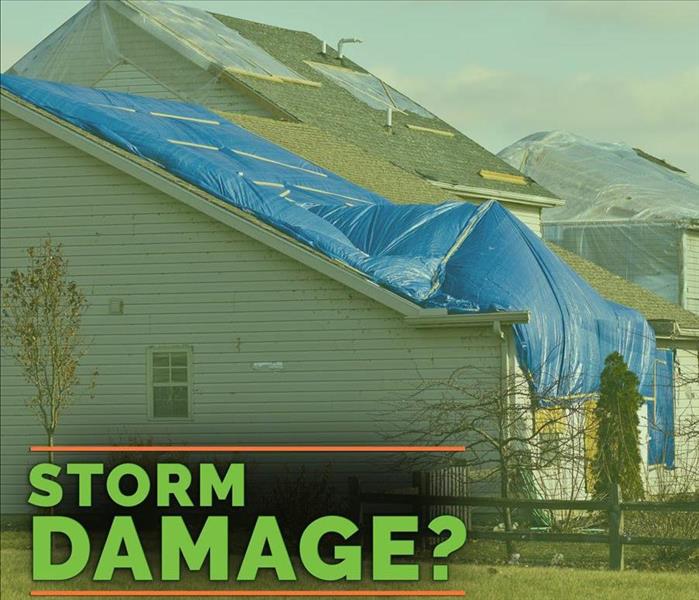
Severe storms such as hurricanes and tidal surges can create a lot of havoc. Flooded houses, washed out roads, and downed power lines are just a few examples of the destruction that these storms can cause. Once the worst of the storm is over, it’s important for homeowners in Clear Lake, TX, to be smart about flood water and other hazards while dealing with the analysis and restoration of their destroyed homes. Here are a few things you should be aware of before getting ankle-deep in the recovery process.
Don’t Return Immediately
Once the rain has stopped, it might be tempting to return as soon as possible to assess your home’s damage. However, this could be a dangerous move if the weather is still erratic or if the area where you live is currently hazardous. Before you return, here are a few suggestions:
• Wait until authorities indicate that the flooded area is safe
• Stay away from power lines or trees that have fallen
• Watch the news for any updates or warnings
Wait until it’s safe to return to your home so you can reduce the risk of getting injured.
Avoid Flood Water
If you are dealing with a flooded home, there is likely to be a few low areas that are still submerged in water. Do not come in direct contact with this water because it can contain sewage and harmful pollutants that could harm your wellbeing. Being exposed to unsanitary water can lead to serious health issues or infection, so be sure to wear protective clothing.
Discard Contaminated Possessions
Once you’ve re-entered your home and started the restoration process, be sure to get rid of any furniture or possessions that were exposed to flood water. Unless thoroughly cleaned, these items are dangerous. Be sure to either dry clean or discard any contaminated items of clothing so that harmful pollutants do not come into direct contact with your skin.
You may want to contact a professional company to help you assess the water damage, remove debris, and sanitize your home. By following these tips, you can be safest while dealing with any storm’s aftermath. For more information about storm damage, visit http://www.SERVPROclearlake.com.
4 Tips on Flood Damage Control
1/24/2018 (Permalink)
After a flood, it’s time for you to start thinking about cleanup. Without the right equipment, you may wonder how to get the water out of your basement or home. In case of flooding in Clear Lake, TX keep these four tips in mind.
1. Flood Water Is Always Contaminated
No matter where the flood originated, it’s safest if you always treat the water as contaminated. If the flooding was caused by a storm, or if the water has stood for more than a day, then odds are it is contaminated. You don’t want to be caught in contaminated waters without the proper equipment, so it’s safest to always assume the water is black water.
2. Don’t Let Standing Water Stand
The longer standing water is left, the worse the damage can become. For instance, mold grows within 48 hours and as early as 24. The longer the moisture stays, the harder it might be to dry your walls and furniture. Additionally, the structure could also become soggy and prone to rot if left for too long. As soon as possible, water should be removed by a sump or trash pump operated by a professional.
3. Dehumidify Your Home
A dehumidifier could help if your home or basement has flooded. This helps dry everything out once the water is removed. Remember that any moisture left behind can lead to mold growth. Pumps can get rid of excess moisture.
4. Look for Trapped Water
Once the water is gone and you have dehumidified, you may think the job is done, but this isn’t always the case. Make sure to check around for trapped mud or water. If you miss anything, it’s possible mold will still grow, which means you’ll likely continue to experience water damage.
Clearing out water after a flood and taking care of the subsequent moisture can be overwhelming at first. However, with these tips, it shouldn’t be difficult to remember what needs to be done and the equipment that should be used. Visit http://www.SERVPROclearlake.com for more information on storm damage.
How to Prepare Your Property for an Oncoming Storm
12/18/2017 (Permalink)
How to Prepare Your Property for an Oncoming Storm
Oftentimes, business owners will hear about a storm well in advance. While there are times that a flood watch could be little more than a false alarm, there are too many cases where it isn’t. It’s never a good idea to wait on storm preparation. Here are three preparation steps professionals in restoration strongly suggest to business owners to help them handle oncoming storms and flooding.
1. Clean Gutters and Storm Drains
Gutters and storm drains are your first defense against flood waters. If your gutters are clogged, then they may not be able to withstand the weight of storm debris. After all, the water will build up even more than if the gutter were clear, and this could cause extensive damage. Storm drains have a similar issue. If not cleared in advance, they could be clogged and this will cause the flood to be worse, as it has nowhere to run off.
2. Protect Your Important Items
In case of a storm warning with major flooding expected, you should remove all of your electrical appliances and valuables before the storm. This includes furniture and rugs. Anything that could be damaged by the water and will be a burden on your business shouldn’t be left behind. Once the storm hits, the rest happens quickly. You want to make sure you move these items in advance.
3. Put Away Important Documents
Many important documents can’t be replaced. This can include financial or other business information. Once these documents have sustained storm damage, then that’s the end of them. You can file documents away in plastic, airtight containers or a waterproof safe and store them on higher ground away from the flooding.
If you’re dealing with flood potential in Clear Lake, Texas you have to remember that preparation is usually the key to dealing with less damage. The more that you prepare, the easier it will be to restore everything when it’s finished. Even if you aren’t sure the flood damage will be extensive, it’s better to be safe. Visit http://www.SERVPROclearlake.com for more information on storm damage.
Expert Storm Damage Remediation
11/2/2017 (Permalink)
Expert Storm Damage Remediation
Many places encounter storms and severe weather events. Heavy rainfall and flooding lead to tremendous damage to property. The losses that come as a result of these weather events must be dealt with efficiently. Storm damage repairs aren’t as easy as most people think.
Flooding, river flooding, hail storms, ice dams, and hurricanes accompany most storms. These two are very dangerous and can cause damage to lots of properties. Floods can lead to sweeping away of houses, cars and even people. Hurricanes are known to carry away roofs and any object that doesn’t firmly stand on the ground from flood water. On the other hand, storms cause ice damming and storm surges that can hurt people.
Businesses just like any other property are prone to wind damage and roof damage which might be caused by river flooding. The act of storm damage restoration is for people with experience and knowledge in such matters. Seeking roof damage and hail damage professional help has numerous advantages and is incomparable to ‘Do it Your Own’ methods. An expert will inspect, identify the damages, come up with a cost-effective measure and undertake the actual restoration procedure. Moreover, the restoration agency will provide a guideline on how to avoid and deal with future storms.
Property owners should immediately seek help to get storm restoration services. They assist in the following;
• Roof repair
• River flooding
• Roof leak
• Hurricane damage
• Water restoration
• Frozen pipes
• Ice damming
• Roof repair
• Wind damage
• Flood water
• Home restoration
• Ice damage
• Storm remediation.
The team of roof damage, hail damage, and ice damage experts comes up with plans on how to tackle the above disasters as soon as possible. They also provide flood pump amongst other services. As a result, there will be cleaning of walls, repair of frozen pipes caused by roof damage, removal of standing water, river flooding and groundwater through storm remediation.
What is the Process of Storm Damage Restoration?
The ice dam victims should immediately contact the storm restoration and ice dam companies as soon as the ice dam disaster occurs. The ice damming companies usually have flood pump, trucks, and workforce that can respond quickly.
On arrival, the storm restoration experts begin with the assessment of the damages. The obligation is to come up with a report on the losses. The next stage involves sealing of holes on roofs and walls. The storm restoration experts begin with the walls and ceilings so that they avoid more damages from occurring. Moreover, sealing ensures that there will be no more wind damage, hail damage, ice damage, and roof leak through storm remediation.
Water extraction and roof leak is the third step in storm damage restoration. This procedure requires specific tools such as flood pump and that’s why only a storm and home restoration organization can offer such services as storm remediation. The roof leak and roof repair team will be able to remove victims stuck in flooding areas safely. In instances of ice damming, the group provides airlifting and flood water services to flood water victims. Other than having flood pump, the water restoration team usually has lots of experience and can deal with the disaster effectively.
Storm remediation also involves the use of dehumidification and drying water restoration procedures to make the rooms go back to their original states. Dehumidification comes in handy in cases of ice damage. They also dry the furniture, clothes and electrical appliances with use of specialized equipment during home restoration.
Cleaning follows after the property is free from ground water. The flood water team tides up property such as furniture and walls. Moreover, they inspect if molds could have taken advantage of the situation. If they have, they treat the fittings to prevent mold from spreading.
Once the room is thoroughly dry from ground water, the following step is to conduct the home restoration process. In cases of both commercial and residential areas, flooding affects things such as wiring and plumbing to check for frozen pipes. The professionals perform a thorough ground water inspection to ensure all these processes are running smoothly. After that, if the owner wishes they can remodel and change the designing of the house so that they can resume their day to day activities.
The final step is known as ground water mitigation. It is a remedy for businesses that are in stormy areas through storm remediation.Prevention is better than cure; therefore the method aims at ensuring the disaster does not occur again. The professionals will conduct roof repair, and deal with frozen pipes to avoid re-occurrence of such tragedies.
Storm damages and hurricane damage, hail damage, and ice damage can cause stress and are quite expensive. The best and most effective way to deal with hurricane damage is seeking storm remediation, hurricane damage services such as professional storm and water restoration come from experts. They will advise on how to plan, deal with groundwater, wind damage and return your property to its original state.
Visit http://www.SERVPROclearlake.com for more information on storm damage.
What Storm Damage Professionals Do After a Storm
9/26/2017 (Permalink)
What Storm Damage Professionals Do After a Storm
The United States experienced the effects of hurricane damage three times in a row in 2017 after Harvey, Irene and Jose swept across the country. While hurricane damage is something that can occur on both commercial properties and private homes, it's not the only type of damage that storm restoration professionals deal with on a regular basis. Storm restoration professionals can also help with any type of flooding like river flooding, a roof leak, wind damage, an ice dam and ice damage that requires a roof repair. Ice damming can also cause other forms of roof damage and lead to problems with ground water and frozen pipes, but home restoration professionals can help with all types of storm remediation.
Property Inspection
One of the main things that storm damage companies can and do after a storm is a full property inspection. They do not just look at the problem that the owner called about because they know that other problems can exist. Hail damage may cause a roof leak or tear the shingles off, which will require a roof repair. Any flood water in the building can freeze and cause frozen pipes to form. A full inspection will also check for wind damage, roof damage, ice damage, hurricane damage and any type of hail damage.
Removing Water
An easy way to remove flood water or ground water on the floor and in other areas of the building is the use of a flood pump. Those who live near the coast or a body of water often have a permanent flood pump set up in their basements or near their foundations. With river flooding or any other type of flooding, the flood pump will carefully extract that water from the property. These pumps can also work in other types of storm remediation. A water restoration or home restoration expert might use a flood pump to remove water that caused ice damming on the sides of a building as soon as that ice dam melts.
Drying
Extracting the water left behind by ice damming or flooding is just one step in the drying of the home or business. Once the excess water caused by river flooding or another type of storm damage is gone, they can use fans and other procedures to completely dry any remaining flood water or ground water. That flood water might enter the home because of a roof repair that went unnoticed, a roof leak no one spotted, wind damage that broke a window, hail damage to the roof or because of an ice dam. Ice damage relating to frozen pipes can cause flooding too. Home restoration experts can dry any water caused by roof damage as part of the process of storm remediation.
Insurance Help
Those calling for storm restoration help or because they need help with water restoration after river flooding will find that storm damage professionals can help them navigate through the often tricky world of filing an insurance claim too. Insurance companies may refuse to accept a claim because of a roof leak that already existed, a previous roof repair or because the owner did not take steps to prevent wind damage or roof damage like ice damming. With the help of a good company, commercial property owners and those who own their own homes or rental properties can file an insurance claim and get the necessary storm remediation.
Some of the common ice damage issues that can arise in winter include an ice dam forming and hanging off the side of a gutter and frozen pipes that break open and spill ground water all over the floors. Other seasons can bring both hurricane damage and hail damage. Storm restoration companies have experience in all types of restoration work and can help clients with any type of water restoration or home restoration work. Visit http://www.SERVPROclearlake.com for more information on storm damage.
Three Risks After a Hurricane
9/13/2017 (Permalink)
Clear Lake will often have hurricanes which leave devastation along its wake. It is important to keep an eye out for these three potential risks after a hurricane.
- Bodily Harm - Flood water carries bacteria and other contaminates. Before entering your home wear proper protective equipment such as gloves and goggles. It is also important to have all your vaccinations such as Hepatitis and Tetanus.
- Electrical Shock - Many power lines and cables will be damaged during the storm. If the power has not been cut from the lines then they can pass electrical currents along the flood water.
- Local Wildlife - Be careful during the clean up process as many wildlife creatures will also be homeless or maybe in a new home; your home. It is common to find snakes and rats trying to stay on high ground.
Remember these risks before doing any cleaning and remediation after a hurricane. Stay safe out there.
Handy Information after a Hurricane
9/13/2017 (Permalink)
Handy Information after a Hurricane
Texans are not rookies when it comes to hurricanes and storms. They understand that stores will be closed, gas lines will be long, and electricity and phone use will be sporadic. It is also important to know what to expect from a SERVORI as the cleanup process begins.
Wait Times - There will be some wait times as there are hundreds of calls being handled by the restoration company. SERVPRO is a national franchise with a large call center to help take in all the leads of homes that need to be cleaned. The good news is that all the SERVPRO companies will be invited to help with cleanup. As more SERVPRO crews arrive more work can be handled lowering the wait times.
Demolition and Repair – There will be a lot of the home that will be torn out as flood water is considered “black water”. The home will be functional but carpets, wooden cabinets, and some drywall will be removed from the home. Repairs will take a long time as electricity and materials will be hard to come by. Hardware stores will try and stock their shelves but without power tools the repairs will have to wait.
Hurricane Safety Tips for Clear Lake
9/12/2017 (Permalink)
Hurricane Safety Tips for Clear Lake
Texas hurricanes are a serious threat to coastal areas. In order to know if the risk for hurricanes is severe in your area, heed local weather reports and be aware of the difference between area advisories.
• Hurricane Watch – This means the threat is less than 48 hours away; look over your hurricane plans and be prepared to act in case of a warning.
• Hurricane Warning – This means hurricane conditions are anticipated within 36 hours. Finish up any preparations and vacate the area when instructed.
• Tropical Storm Watches and Warnings – This signals that a tropical storm is a threat to your location. Dangerous winds and flooding are possible, so pay attention to these advisories.
If you live along the coastlines or in one of the top 10 danger zones, you are at higher risk than most. Keep the advisements top of mind during hurricane season to keep you and your property safe.
If your home suffers damage after a hurricane call SERVPRO of Clear Lake from our main page.
Planning for a Hurricane
9/12/2017 (Permalink)
Planning for a Hurricane in Nassau Bay
Coastal hurricanes can be made less severe by taking these simple steps.
1. Plan Ahead
2. Heed Authorities
3. Stay Calm
Plan Ahead
• Pack a "go bag" backpack with all the necessary supplies, such as food water, and all of the other essential supplies that you will need.
• Put important documents, such as medical information, identification, insurance policies, and official documents into an easily accessible waterproof container. .
• Put together a plan including your destination if you are to evacuate, as well as the time and means of family members contacting one another once away from the area. Make sure gas tanks are full.
• Unplug small appliances in your home, turn off propane tanks, and eliminate all potential safety hazards. Put your freezer and refrigerator on the coldest settings and keep them closed, so that the coolness is retained in case of a power outage.
• Close hurricane shutters, doors, and windows, when you leave. If there are no hurricane shutters, close and board up doors and windows with plywood.
Heed Authorities
• Listen to the local news or a NOAA Weather Radio for updates.
• Only return home when officials declare it safe.
• If you live in a home that is not sturdy enough to withstand the wind, such as a mobile home, evacuate early.
Stay Calm
• Practice your hurricane escape plan beforehand so that you are well prepared.
• Avoid washed out bridges, flooded roads, and other unnecessary risks. Use your road maps to find safe escape routes.
• Give children fun activities to do and reassure them that everyone will be staying together.
Quick Tips for Working with Your Insurance for Restoration – Clear Lake
2/21/2017 (Permalink)
 Don't drown in paperwork after a storm damage claim.
Don't drown in paperwork after a storm damage claim.
Regular life is stressful enough, but if you are surprised with flooding or other water damage in your home, everyone in the household will be stressed. Whether Houston flood damage leaves carpeting soaked and soggy or you have come back to a disaster after evacuation, severe weather and damaged pipes will cause significant worry about how to start putting back together your daily life.
However, you can prepare for these unknowns by knowing what to expect and create a plan in case of emergency. To assist you, SERVPRO Clear Lake has put together this mini-guide to help you understand the flood insurance claim process.
The first thing you will want to do is call your insurance provider. Although the U.S. government funds the National Flood Insurance Program (NFIP), local home and rental insurance companies are the exclusive sellers of Flood Damage Insurance. While you will be working directly with an insurance agent, SERVPRO can also serve as a liaison, helping you to navigate through the claims process.
After your initial call to your insurance company, contact your Clear Lake area SERVPRO. We are available every day, all day, to handle your emergencies. Even if you are not able to reach your insurance agent immediately, SERVPRO will take your call and begin to work with you on first response remediation solutions. Have questions about what to do first or what items can be restored? Clear Lake SERVPRO is here to answer those questions and more. Our compassionate team understands your distress and will guide you through the storm damage restoration process.
Now you can begin your water damage restoration. We pride ourselves on having the fastest response time to storm damage in your area. We will arrive at your home prepared to conduct an inspection and moisture readings, create a scope of the damage and provide an estimate for you and your insurance provider. Our team will arrive prepared and ready to start immediately. Using our dedicated SERVPRO Claims Information Center (CIC) we can store and access your information easily and quickly.
Our SERVPRO team members are the premier flood and water damage restoration experts in Clear Lake and the surrounding areas. We are also the preferred remediation team for home insurance providers, and the most trusted helper for Houston storm disasters. Storm damage restoration and navigating flood insurance claims can feel stressful, but we are here to assist you with every stage of the recovery process.
For emergencies and other situations, call 713-461-2700 anytime to reach your area flood damage experts, SERVPRO Clear Lake. We help residential and commercial property owners when natural disasters, water damage, sewer backups, floods, mold infestations, fires and other events happen.
Houston Home Safety: Essential Hurricane Preparedness
9/19/2016 (Permalink)
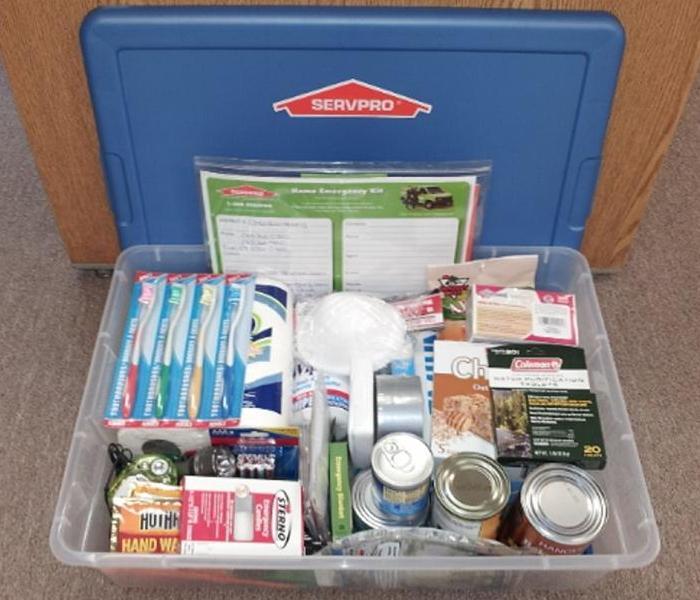 SERVPRO prepared kits will ensure you are prepared throughout the year.
SERVPRO prepared kits will ensure you are prepared throughout the year.
September is National Preparedness Month and for those of us in the greater Houston metro area, it is vital that we stay prepared for severe weather throughout the year. We are all well aware of the damage that a hurricane or flood can inflict on our city and the Houston area water damage sustained by Houston homes and businesses each year. This month, let’s all take the initiative to follow the recommendations provided by the Department of Homeland Security and get prepared for when the next disaster strikes our community.
- Create a Family Emergency Communication Plan. Make sure that all members of your family, those living in the Houston area, and those outside the area, know how to communicate during severe weather. Remember, mobile phone networks are often overwhelmed during a disaster so have a plan to use landlines, texts, and emails. Also, it is important to recognize that you need a rallying point to reunite if you are separated, or become separated, during the emergency. Your local Houston SERVPRO encourages you to prepare for any special needs of the family, and pets. Keeping a supply of medications on hand during severe weather season, and copies of important papers and documents in the Cloud for easy retrieval is recommended.
- Preparing Kids. It is vital for the safety of your children that in the event disaster strikes while they are at school, or away from home, that they know what to do. The Family Emergency Communication Plan recommended above must be accessible to your children as well. For some families, the addition of an out-of-area family member to the communication plan that can act as the go-between during an emergency is helpful. Parents should also request a written copy of the children’s school (and daycare) emergency plans, so you know where to reunite with your children.
- Elderly Family Members. Make sure that older adults in your family know how to use technology that can help during an emergency, and be sure that they have the support they need during an emergency to evacuate if necessary. Helping family members create a “go bag” that has their medications, and important papers will help tremendously in the event a disaster strikes the greater Houston area.
- Plan with Neighbors. It is wise to reach out to your neighbors and share communication plans and evacuation plans. If your children or their children are home alone during severe weather or another emergency, it is imperative they understand where to turn for immediate help.
- In the midst of a hurricane or other emergency, it is vital that you remain safe. Don’t drive through floodwaters, don’t walk through water where power lines are down and don’t enter properties that are flooded. Be cautious; floodwaters carry many hazards including wildlife and sharp debris, and it moves fast and can quickly whisk you away.
A little preparation in advance of a hurricane saves lives and property. Your Houston SERVPRO team wants to remind you that if disaster strikes, we stand at the ready to help you through all aspects of the storm and water damage, from water extraction through rebuilding. Call us any time, we have crews available 24 hours a day and stand at the ready to assist our community whenever disaster strikes.
About The Clear Lake SERVPRO
SERVPRO of Clear Lake is Faster to Any Size Disaster, helping residential and commercial property owners when natural disasters, water damage, sewage backups, floods, fires, mold infestations, and other events happen.
Clear Lake Home Health: The Definitive Summer Storm Checklist for the Greater Houston Area
6/2/2016 (Permalink)
SERVPRO of Clear Lake wants to remind our community that we are heading into severe weather season. It is imperative to prepare for the worst-case scenario, because a slow-moving thunderstorm, hurricane, or other event can cause significant water damage in the greater Houston area, making it difficult to evacuate or even get around. As we have witnessed over the last few years, flood damages our local businesses, homes, roads, and the infrastructure we depend upon. Use this checklist in the event a natural disaster is forecast for Clear Lake and surrounding areas:
Now:
1. Develop and Test an Evacuation Plan. Make sure every family member knows the evacuation plan and an alternate route in the event roads are blocked.
2. Inventory your Home. Take photos and videos, and complete an inventory of all items in your home, garage, attic, and any storage sheds. Back up this information offsite.
3. Develop and Test Your Communication Plan. Plan and test two scenarios, the first for a storm or event forecast in advance, and the second for an emergency situation with no warning. Include family and friends outside the zone.
4. Make Plans for Pets. Where will pets stay and how will they be transported in the event you must evacuate? Make sure they are up to date on all shots, are micro-chipped, and that you have piddle pads or newspapers on hand in the event they need to relieve themselves during a vicious storm.
5. Purchase a First Aid Kit. Make sure to include elastic bandages, scissors, tape, antibacterial creams, and general wound care items.
6. List Items for a “Go Bag.” Each family member and pet should have a dedicated bag that can be quickly filled with necessary items in the event you must evacuate immediately. Include clothing for severe weather and its aftermath, including boots, eye protection, gloves, long pants, long-sleeved shirts, undergarments, sleeping attire, and items for personal hygiene.
7. Clean Up Landscaping. Trim any low tree branches, as well as branches that could go through a window or damage the roof. Remove debris from gutters and make sure gutters have extenders to drain excess water away from home.
8. Schedule a Roof Inspection. It is wise to schedule an annual roof inspection prior to storm season each year to prevent leaks and damage to your home.
9. Check Window Well Covers for Cracks.
10. Test Sump Pump, Backup Battery, and Hose.
11. Store Important Documents in Watertight Containers. These include passports, birth certificates, marriage/divorce decrees, and other documents as necessary. Preferably, scan and keep all items in offsite or Cloud storage.
When Storm is 2-3 Days Out:
1. Purchase Plywood for Windows and Doors.
2. Backup Computer, Phone, and Tablets.
3. Fill all Vehicles with Fuel.
4. Purchase Ample Water. A good rule of thumb is one gallon per day, per person in the home. Don’t forget that pets will also need water.
5. Store 3-5 Days’ Worth of Non-Perishable Food.
6. Stage Flashlights Throughout the Home and Test Batteries. Purchase headlamps for greater security and hands-free operation. Many have a flashing red light setting for emergencies.
7. Test Battery-Powered Radio.
8. Pack “Go Bags.” Add clothing, medications, important papers, and your evacuation and communication plans.
9. Turn Refrigerator and Freezer to Coldest Setting. In the event power is shuttered, this will give your food more time at safe temperatures. You can freeze a gallon or two of milk, and once power is off, keep items cool in the refrigerator.
10. Listen to Local News Outlets. Heed storm warnings. Pay particular attention to the location of shelters in your area.
When Storm is 24 Hours Out:
1. Close Shutters or Board up Windows with 5/8 inch Plywood and Reinforce Garage Door. This can help prevent water and other storm damage to your home.
2. Bring all Outdoor Items Inside. This includes patio furniture, BBQ grills, and other items that could become projectiles in the event of high winds.
3. Fill Bathtub with Water. This water can be used for personal grooming, flushing the toilet, etc. Water may not be drinkable after a significant weather event.
4. Charge All Devices.
5. Gather Board Games and Coloring Books for Kids. Set up a play area in an interior room with items to keep them occupied during the storm.
During the Storm:
1. Unplug Electronics.
2. Stay Inside.
3. Follow Local News and Heed All Warnings.
4. Wear Whistles Around the Neck. In the event you need to evacuate or your home becomes damaged, each person should be wearing a whistle.
5. Evacuate if Recommended Via Your Evacuation Plan, or as per First Responder Instructions.
When the storm has passed, remember that flooding is still a possibility for some of the lower lying areas of our community. Never drive or walk through flooded areas, as floodwaters are extremely powerful and can carry potentially hazardous wildlife and debris. If your Clear Lake or surrounding area home is damaged, call Clear Lake SERVPRO immediately. We can work directly with your insurance company to fix the damage caused by seasonal storms.
Clear Lake Home Health: 6 Risks of Improper Storm Damage Restoration
3/15/2016 (Permalink)
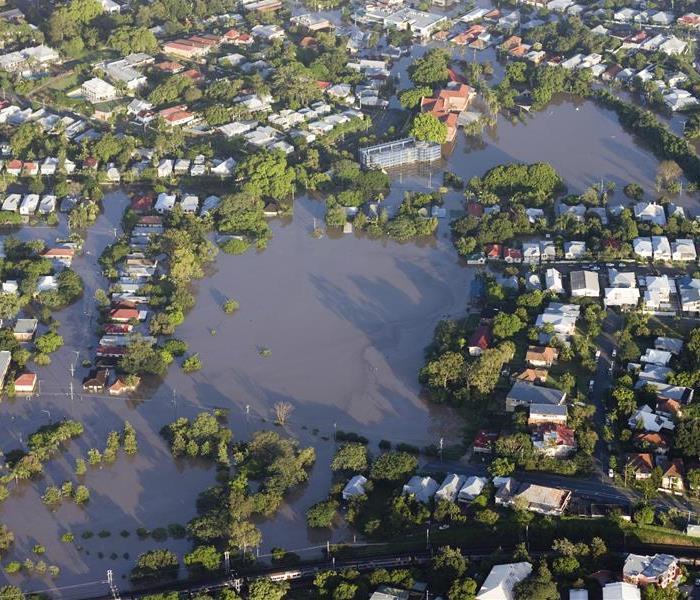 SERVPRO's Professionals have the expertise and the resources to handle any size disaster and can respond immediately to storm and flooding conditions.
SERVPRO's Professionals have the expertise and the resources to handle any size disaster and can respond immediately to storm and flooding conditions.
From time to time, Mother Nature takes its toll on the Houston area. Hurricanes, torrential downpours, tornados, and other significant weather events can cause significant water damage in Clear Lake and surrounding communities. While it may be tempting to jump start the restoration process, here are 6 risks you must be aware of:
1. Injury. Flood waters in our area carry bacteria and significant amounts of debris. Prior to starting the cleanup process, proper protective clothing, eye wear, and a tetanus shot are highly recommended. Exposed skin that comes in contact with flood waters can cause infections and illness. If the electricity has not been turned off by the utilities company, you are at risk of electrocution. In addition, if natural gas has not been turned off, dangerous fumes may be emitting from dryers, kitchen ranges, space heaters and water heaters. Proceed with extreme caution before entering your home.
2. Wildlife Injuries. Wildlife gets caught up in the flood too, and waters often carry poisonous snakes, insects, and rodents. When the flood waters begin to recede, it is important to do a thorough investigation into closets, corners, behind furniture, duct work, attics, and crawl spaces where wildlife may be hiding. Bites from wild animals can lead to serious injuries.
3. Asbestos Dangers. Removal of items with asbestos must be removed and disposed of properly. This is not something that should be attempted by homeowners. A professional flood damage restoration team in Clear Lake and surrounding areas is highly recommended. Asbestos is commonly found in homes with vinyl or linoleum floors and in some pre-1990 homes in drywall, ductwork, and insulation. If you have an older home, proceed with extreme caution.
4. Bacteria. After a flood, every surface and item in the home must be properly disinfected. As mentioned above, flood waters carry harmful levels of bacteria. Without thorough disinfecting, items in your home may remain hazardous.
5. Mold. Often, construction after a flood begins too soon. If the humidity levels in the home are not brought down to safe levels, and drywall or other structural elements are not thoroughly dried prior to restoration, mold will develop. The best course of action for mold prevention in Clear Lake is proper dehumidification with advanced drying equipment.
6. Severe Stress. Not to be overlooked is the time, money, and stress of attempting water damage restoration yourself. Your locally owned SERVPRO of Clear Lake has undergone extensive training, and we have the experience, and tools necessary to bring your home back to pre-storm damage condition. We work directly with insurance companies to ease the process, and we stand at the ready to help our neighbors, 24 hours a day, 7 days a week.
In Clear Lake, water damage, storm damage, sewage backups, fires, and mold remediation can all be handled by Houston SERVPRO. When disaster strikes, call us immediately. Our process begins the moment you call. Our team will them come and inspect and assess the property for damage, and begin the water removal, and drying and dehumidification process. Then, we move forward with the cleaning and repair, and lastly, we begin the restoration process when appropriate.
About The Clear Lake SERVPRO
SERVPRO of Clear Lake is Faster to Any Size Disaster, helping residential and commercial property owners when natural disasters, water damage, sewage backups, floods, fires, mold infestations, and other events happen.

 24/7 Emergency Service
24/7 Emergency Service




























